Inbox and environment news: Issue 482
February 7 - 13, 2021: Issue 482
Time Of Burran
Gadalung Marool (hot and dry) January - March
The behaviour of the male kangaroos becomes quite aggressive in this season, and it is a sign that the eating of meat is forbidden during this time. This is a health factor; because of the heat of the day meat does not keep, and the likelihood of food poisoning is apparent. The blooming of the Weetjellan (Acacia implexa) is an important sign that fires must not be lit unless they are well away from bushland and on sand only, and that there will be violent storms and heavy rain, so camping near creeks and rivers is not recommended.
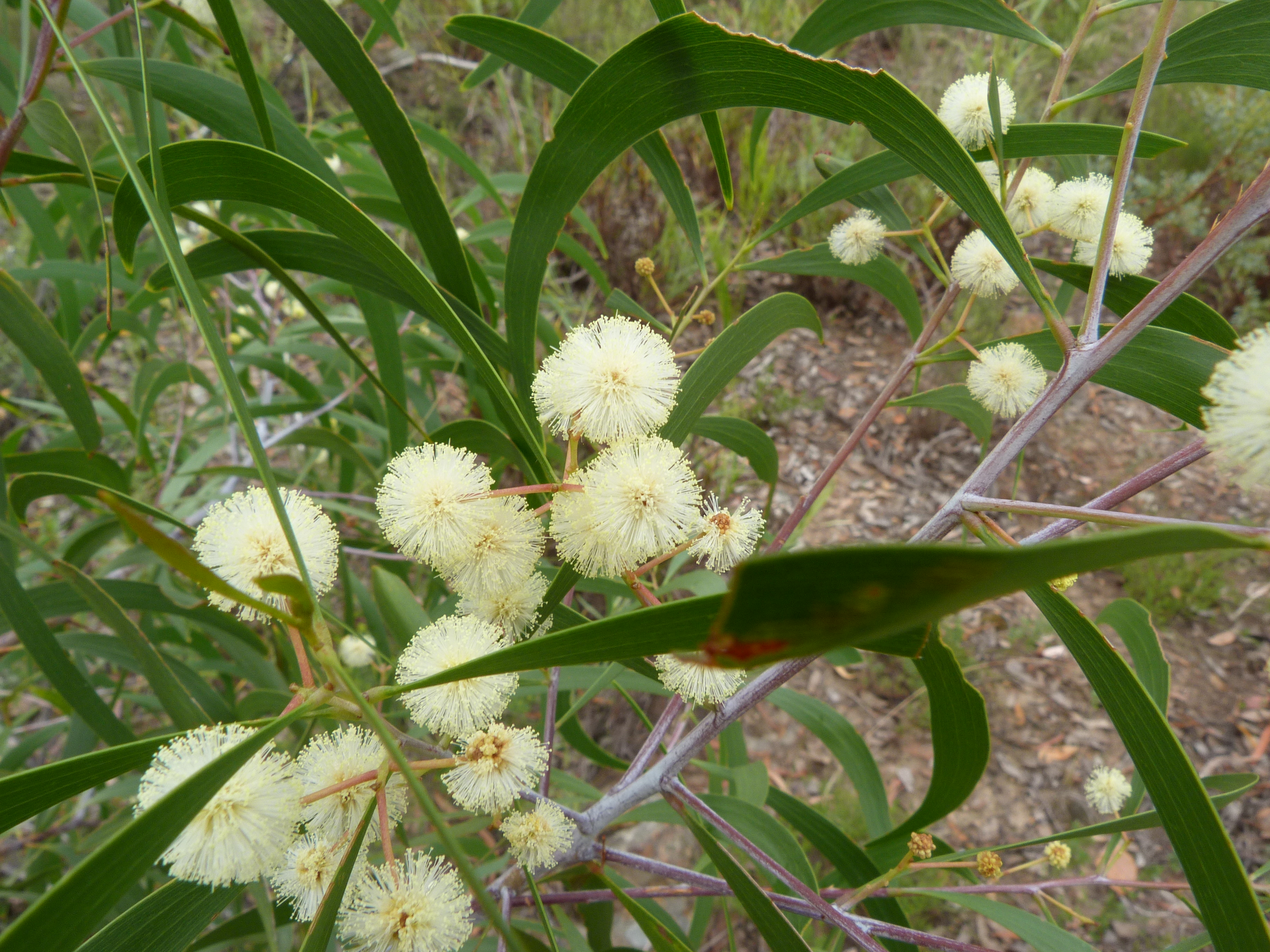
Acacia implexa, commonly known as lightwood or hickory wattle, is a fast-growing Australian tree, the timber of which was used for furniture making. The wood is prized for its finish and strength. The foliage was used to make pulp and dye cloth. The Ngunnawal people of the ACT used the bark to make rope, string, medicine and for fish poison, the timber for tools, and the seeds to make flour.
It is widespread in eastern Australia from central coastal Queensland to southern Victoria, with outlying populations on the Atherton Tableland in northern Queensland and Tasmania's King Island. The tree is commonly found on fertile plains and in hilly country it is usually part of open forest communities and grows in shallow drier sandy and clay soils.
Acacia implexa flowers - photo by Donald Hobern.
Flight2Light 2021: 'How To'
Bush Blitz, is partnering with the Australasian Dark Sky Alliance to raise awareness of the impacts of light pollution on the night time environment.
The Flight2Light event aims to educate Australians about light pollution, the impact it has on wildlife and the simple ways they can reduce light pollution.
You can get involved in Flight2Light from the 6th-19th Feb 2021
Check at Bush Blitz for information about how to register to take part in this nation wide event, receive a participation certificate and the satisfaction of helping our environment.
Ross River Fever In Pittwater: What You Can Do To Beat Those Mosquitoes
Recent damp and humid weather is bringing out the mozzies, LOTS of mozzies - a reminder that Ross River Fever and Barmah Forest virus are now in our area and there are a few tips you can follow to keep you and your family safe:
1. It is important that if you’re spending a lot of time outdoors in these areas, especially close to wetlands and bush land areas at dawn and dusk when mosquitoes are most active, that you take action to reduce the risk of being bitten. Cover up with long sleeved shirts and long pants and apply an insect repellent. Choose a repellent that contains either DEET (diethlytoluamide), picaridin, or oil of lemon eucalyptus. Apply it to all exposed skin to ensure there is a thin even coat – a dab “here and there” doesn’t provide adequate protection.
2. You can also reduce the incidences of mosquitoes breeding by removing any shallow dishes of water or, if you have these out to feed wildlife and birds, regularly change the water so the stagnant water climate for them to breed is removed. Outbreaks can occur when local conditions of rainfall, tides and temperature promote mosquito breeding, so if we have rain followed by a warm day, check any receptacles in your garden and make sure they are emptied of water.
3. It is also a good idea to ensure you're not being bitten while asleep - repair any flyscreens that are damaged, or install them where absent. There are also a range of plants you can incorporate into your garden that repel mosquitoes and attract mosquito eating insects, such as dragonflies, or birds, possums, frogs and bats that will also reduce their numbers by eating them.
4. Similarly, if you're out and about in our wetland areas not chasing off or disturbing the wildlife that lives there, such as turtles or ducks, with ducklings just a few days old known to eat mosquitoes, will help. They eat them - we need this wildlife.
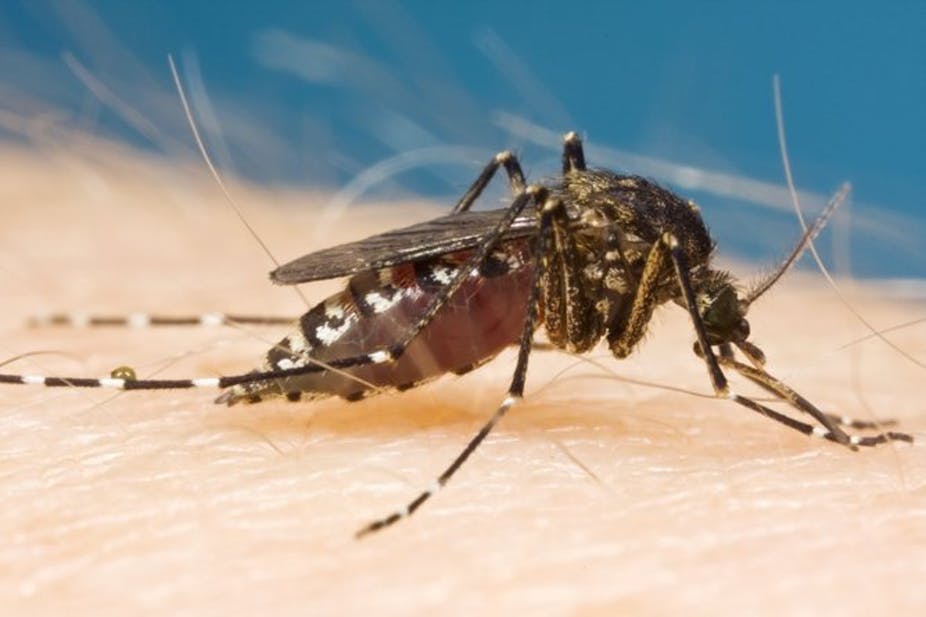
The saltmarsh mosquito, Aedes vigilax, transmits Ross River virus in many coastal regions of Australia. Photo: Mr Stephen Doggett (Medical Entomology, Pathology West - ICPMR Westmead)
Discussion On February 11, 2021: Environmental Issues On Our Northern Beaches
Right now, climate damage and habitat destruction are putting our coasts and communities at risk. From sea level rise and coastal erosion, to land clearing and unsustainable development, our beautiful region faces a number of environmental challenges.
That’s why we’re bringing your local federal Member of Parliament and other experts together to discuss the environmental issues facing Sydney’s Northern Beaches – and how together, we can keep our coasts and communities healthy for generations to come. Will you join us?
What: Healthy coasts, healthy communities: an online panel discussion
When: Thursday 11 February, from 7-8pm AEDT
Where: Online on Zoom. RSVP for the link.
Join our stellar lineup of speakers, including:
- Layne Beachley AO – 7-time world champion surfer and environmental campaigner
- Dr Vanessa Pirotta – wildlife scientist and science communicator
- Jason Falinski MP – federal member for Mackellar
Plus Lynne Malcolm – ABC presenter and former host of All in the Mind podcast – as our MC for the night.
Once you’ve RSVP’d to the event you’ll have an opportunity to submit a question to any of the panel speakers. With such a wealth of knowledge and expertise behind them, we’re sure you’ll have lots to ask!
Hosted by the Australian Conservation Foundation
Upcoming Activities For Friends Of Narrabeen Lagoon Catchment:

Sun 21 February 2021: 7.30 am Walk & Weed along the Narrabeen Lagoon catchment transverse walk.
Start at Oxford Falls walk for 3 1/2 hours, weed for 30min, continue 30min walk and car pool back to start.
Bring gloves and long handled screwdriver if available.
Walk grade: medium.
Bookings essential. Conny 0432 643 295
https://www.narrabeenlagoon.org.au/
Friends of Narrabeen Lagoon Catchment are pleased to announce the next forum will be held on 22 Feb 2021 at 7 pm .
Presenter: Jayden Walsh
Jayden is a keen observer of nature and has some stunning photographs and information to share.
The focus will be on wildlife that lives near the Narrabeen Lagoon and that, if you are fortunate, you may see when on the Narrabeen Lagoon walkway.
For details on how to book for this event are on the website. At: https://www.narrabeenlagoon.org.au/Forums/forums.htm
Bushcare In Pittwater
Where we work Which day What time
Avalon
Angophora Reserve 3rd Sunday 8:30 - 11:30am
Avalon Dunes 1st Sunday 8:30 - 11:30am
Avalon Golf Course 2nd Wednesday 3 - 5:30pm
Careel Creek 4th Saturday 8:30 - 11:30am
Toongari Reserve 3rd Saturday 9 - 12noon (8 - 11am in summer)
Bangalley Headland 2nd Sunday 9 to 12noon
Bayview
Winnererremy Bay 4th Sunday 9 to 12noon
Bilgola
North Bilgola Beach 3rd Monday 9 - 12noon
Algona Reserve 1st Saturday 9 - 12noon
Plateau Park 1st Friday 8:30 - 11:30am
Church Point
Browns Bay Reserve 1st Tuesday 9 - 12noon
McCarrs Creek Reserve Contact Bushcare Officer To be confirmed
Clareville
Old Wharf Reserve 3rd Saturday 8 - 11am
Elanora
Kundibah Reserve 4th Sunday 8:30 - 11:30am
 Mona Vale
Mona Vale Mona Vale Beach Basin 1st Saturday 8 - 11am
Mona Vale Dunes 2nd Saturday +3rd Thursday 8:30 - 11:30am
Newport
Bungan Beach 4th Sunday 9 - 12noon
Crescent Reserve 3rd Sunday 9 - 12noon
North Newport Beach 4th Saturday 8:30 - 11:30am
Porter Reserve 2nd Saturday 8 - 11am
North Narrabeen
Irrawong Reserve 2nd Saturday 2 - 5pm
Palm Beach
North Palm Beach Dunes 3rd Saturday 9 - 12noon
Scotland Island
Catherine Park 2nd Sunday 10 - 12:30pm
Elizabeth Park 1st Saturday 9 - 12noon
Pathilda Reserve 3rd Saturday 9 - 12noon
Warriewood
Warriewood Wetlands 1st Sunday 8:30 - 11:30am
Whale Beach
Norma Park 1st Friday 9 - 12noon
Western Foreshores
Coopers Point, Elvina Bay 2nd Sunday 10 - 1pm
Rocky Point, Elvina Bay 1st Monday 9 - 12noon
Gardens And Environment Groups And Organisations In Pittwater
Pittwater Reserves
Extension Of Exhibition For Draft Central Coast Unregulated And Alluvial Water Sharing Plan
The exhibition period for the draft Water Sharing Plan for the Central Coast Unregulated and Alluvial Water Sources has been extended until 14 February 2021, the Department of Planning, Industry and Environment has announced.
Acting Director Coastal and Groundwater Planning, Tracey Brownbill said the exhibition was due to end on Sunday 31 January but will be extended by two weeks to ensure all interested stakeholders can review the draft.
“During this first exhibition phase, some stakeholders indicated they wanted more time to review the plan before making comment,” she said.
“We have listened to the requests and extended the closing date for the public exhibition period to 14 February. This will allow people the time they need to have their say and make a submission.
“A number of public information sessions have already been held to outline the draft plan and answer questions from water users and community members.”
Ms Brownbill said the aim of this water sharing plan is to protect the environment, manage water extraction and facilitate water trading.
The draft Central Coast water sharing plan covers the unregulated rivers and alluvium from north of the Hawkesbury River to north of the Tuggerah lakes and includes the Wyong River and its tributaries.
“Unregulated rivers play an important role in providing long-term security for local farming, industries, towns and the environment,” Ms Brownbill said.
“Once finalised the water sharing plan will be in place for ten years, providing security for both water users and the environment in the Central Coast region.”
Copies of the draft plan, together with supporting information and documents can be obtained from the department's website - dpie.nsw.gov.au/central-coast-wsp.
Submissions must be received by 14 February 2021.
Draft Horse Riding Plan For South East Wollemi National Park
The National Parks and Wildlife Service (NPWS) is encouraging people to have their say on proposed horse-riding opportunities in south east Wollemi National Park before submissions close on 14 March 2021.
NPWS Director David Crust said that following strong local community interest over many years, the Service has developed a draft management plan that proposes a number of recreational trails in the Wheeny Creek – Mountain Lagoon area.
“This draft plan proposes how we will assess, rationalise and formalise horse-riding trails in this area,” said Mr Crust.
“There is a long history of horse riding in the Wheeny Creek – Mountain Lagoon area and under this draft plan riders continue to have a strong connection to this landscape.
“We’re proposing to formalise a series of low-impact riding trails that essentially follow existing park management trails.
“Doing so will minimise impacts on threatened species and the conservation values of the area, as well as tie into our existing trail maintenance program.
“The draft plan will ensure we have management arrangements in place to support unique and enjoyable horse-riding opportunities for the community.
“The plan refers only to a 28,000-hectare section of Wollemi National Park, an area in the south east that was not heavily impacted by last summer’s bushfires.
“We welcome feedback on the plan and encourage members of the public and interest groups to make a submission via formal channels so all comments can be recorded and considered,” said Mr Crust.
The public exhibition period for the plan has been extended and submissions now close 14 March 2021.
To read the Draft Horse Riding Management Plan: South East Wollemi National Park and to find out more:
- NPWS Hawkesbury-Nattai Area, Bowmans Cottage, 370 Windsor Street, Richmond – by appointment via email to: npws.hawkesburynattai@environment.nsw.gov.au
- Hawkesbury City Council, 366 George Street, Windsor
- NPWS Glenbrook, end Bruce Road, Glenbrook - by appointment via email to: npws.hawkesburynattai@environment.nsw.gov.au
- Blue Mountains Heritage Centre, end Govetts Leap Road, Blackheath (9.00am to 4.30pm daily)
If you would like to make a submission please follow the instructions via our website.
Bents Basin State Conservation Area: Have Your Say
Closes March 7, 2021
National Parks and Wildlife Service is seeking feedback on the draft plan of management for Bents Basin State Conservation Area and Gulguer Nature Reserve.
The Bents Basin State Conservation Area and Gulguer Nature Reserve Draft Plan of Management is currently on public exhibition.
Once adopted, the plan will replace the Bents Basin State Conservation Area statement of management intent and the Gulguer Nature Reserve statement of management intent, which were approved in 2014.
Key management directions in this plan include:
- strategies for the protection of natural values
- strategies to improve the management of Aboriginal cultural heritage and shared heritage values
- strategies to improve visitor experiences and manage increasing use.
The draft visitor facilities concept plans, including details of visitor facility upgrades, are also available for comment.
You can provide your written submission in any of the following ways:
Post your written submission to:
Manager Planning
Evaluation and Assessment
Locked Bag 5022
Parramatta NSW 2124
Email your submission to: npws.parkplanning@environment.nsw.gov.au
Make a submission online by using the online form here
Volunteers Needed For Great Inland Glossy Count: February 2021
Postponed from late last year the NSW Saving our Species program is now calling for community volunteers to become 'cockatoo counters' and help be part of the Great Inland Glossy Count this February.
National Parks and Wildlife Service Senior Project Officer Adam Fawcett said the count was set to go and anyone can be a part of it.
"Bird lovers, citizen scientists or anyone with an interest in this beautiful threatened species, are needed to survey glossy black cockatoo populations at three key sites around inland NSW.
"Listed as vulnerable in New South Wales, glossies are easily spotted with their distinctive red markings and this cockatoo count will help our scientists understand more about this threatened bird," he said.
This is the second time the Great Inland Glossy Count has occurred. In 2019 seventy volunteers participated and counted over 700 glossy black cockatoos across inland NSW.
The count is part of a wider project to conserve the species at three key sites: the Pilliga Forests, Goonoo National Park and Goobang National Park and surrounding landscapes.
The dates for the 2021 surveys of what is fast becoming an annual cockatoo count are:
- 13 February – Pilliga Forests
- 20 February – Goonoo National Park
- 27 February – Goobang National Park and surrounds
"We are hoping to get 100 volunteers this year and what a great opportunity to get out to some of our amazing national parks and state forests, sit back and watch a threatened species in its natural habitat," Mr Fawcett said.
Volunteers will need to pre-register using the Department of Planning Industry and Environment's Volunteer Portal and will be required to follow COVID safety guidelines.
Family members are encouraged to register to volunteer together and will be stationed at one dam on their chosen weekend to count glossy black cockatoos as they come into known watering holes.
"We are asking volunteers to setup at their survey site an hour or so before dusk and wait as glossy black cockatoos fly in for water.
"The only requirements are the ability to make your way to a dam allocated by the Saving our Species team and to bring a pair of binoculars, a comfy chair and a notepad.
"Many of our seasoned participants make quite an event out of the evening, with cheese platters and other goodies a regular feature. It is a pretty amazing when you get a large flock of this threatened species coming into a waterhole to drink and we love that we are able to give people this opportunity to get involved in threatened species conservation," Mr Fawcett said.
The project is funded by the NSW Government's Saving our Species program and the NSW Environmental Trust, and is led by Central West Local Land Services in partnership with National Parks and Wildlife Service, NSW Forest Corporation, Dubbo Field Naturalists, Australian Wildlife Conservancy and the land owners and managers within these areas.
Innovative Hydro-Powered Battery Project A First For Australia
February 5, 2021
A $32 million hydro-powered battery project to be located near Albury will be Australia’s first, following approval by the NSW Government.
Minister for Planning and Public Spaces Rob Stokes said the hydro-powered battery will be charged by the nearby Hume Hydro Power Station that already provides power to 40,000 homes.
“The battery will be able to dispatch energy to the grid during peak demand, boosting grid stability and energy security in what is the first co-located battery and hydro project in Australia,” Mr Stokes said.
“Not only does it supply clean and reliable energy, it provides jobs and investment for the local area.”
Minister for Energy and the Environment Matt Kean said the project was a great example of how industry was supporting the State’s growing renewable energy sector through innovation and investment.
"We know New South Wales has some of the best hydro opportunities anywhere in the world and this sort of battery innovation adds to the renewable energy mix right across the State," Mr Kean said.
“As renewable energy becomes a greater part of our energy mix, projects like this will help to support the continued growth of our economy by delivering a modern, cheap and reliable energy grid for the people of New South Wales.”
Member for Albury Justin Clancy said the project’s approval was fantastic news for the community.
“A clean energy project that will create 40 construction jobs and inject $32 million into the regional economy is welcome news for the area,” Mr Clancy said.
It is expected that construction will start later this year.
A major coal mine expansion was knocked back today, but where's the line in the sand?
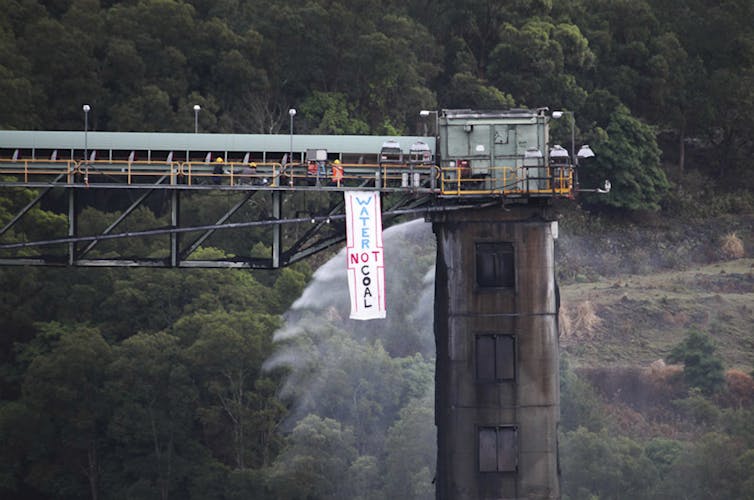
An independent expert panel today rejected a proposal to expand the operations of the Dendrobium coal mine under Sydney’s drinking water catchment. This is a significant and welcome decision. However, flawed environmental laws that enabled the proposal to get so far must be overhauled.
The mine’s proponents had been seeking to extract 78 million additional tonnes of coal out to 2048. The New South Wales Department of Planning, Industry and Environment (DPIE) had recommended the mine be approved. The backing came despite grave concerns over the mine’s impact on drinking water supplies.
We are experts in environmental regulation and one of us, Pete Dupen, is a former mining manager for the state government agency WaterNSW. Our research shows the damage mining causes to Sydney’s water supplies is unsustainable, and regulation in Australia has largely failed to set firm limits on cumulative damage to the environment.
The problem is rife in both state and federal laws, and must urgently be addressed.

‘Unacceptable’ Damage
NSW’s Independent Planning Commission (IPC) was tasked with assessing the Dendrobium mine proposal due to the high number of objections received.
The multinational company that owns the mine, South32, wanted to extend underground longwall mining at the operation until 2048.
Coal from Dendrobium, located west of Wollongong, is used in steel-making in Australia and overseas. South32 argued the expansion would deliver a net economic benefit of A$2.8 billion.
Read more: Be worried when fossil fuel lobbyists support current environmental laws
The extension would have allowed 78 million tonnes of coal to be extracted from two new areas comprising 21 “long wall” panels, 18 of which would have been more than 300 metres wide.
The panels would have been dug out from beneath a so-called “Special Area” – land where, under law, stored water must be protected and ecological integrity maintained. The area covered by the proposed expansion supplies drinking water to much of Greater Sydney.
In its verdict released on Friday, the IPC said the project would cause “unacceptable” damage and should be refused.
Among the reasons for the decision were:
the risk of significant “subsidence” or sinking of the ground’s surface resulting from the longwall mine design. This would degrade 25 watercourses and swamps
potentially significant surface water losses into the groundwater system, damaging ecological processes and contribute to increased concentrations of metals in drinking water
the impact of past and existing longwall mining in the catchment, including the (as yet unquantified) loss of surface water flows from some sections of rivers and streams
uncertainty around managing mine water inflow (surface waters permanently diverted underground) after mine closure.
No Line In The Sand
Thankfully in this case, the IPC took into account cumulative damage to water supplies when making its decision. But as precedent shows, that consideration is not a given.
Australian laws tend to focus on the impacts of individual projects in isolation. Crucially, they fail to use clear thresholds of unacceptable cumulative environmental impact – a line in the sand, beyond which damage will not be tolerated.
The failing is reflected in the recommendation by NSW planning officials that the Dendrobium extension be approved. If cumulative damage was properly considered earlier, the proposal would have been scuppered years ago.
Climate change and drought have crippled urban water supplies in recent years. Yet underground coal mines have been allowed to eat away at Sydney’s water catchments, Pac-Man like, for decades.
Our research shows existing coal mines in the catchments of Sydney’s “Metropolitan Special Area” have, or will, divert 450 billion litres of drinking water into underground fractures. That’s almost as much water as is contained in Sydney Harbour.
A NSW government-appointed expert panel recently examined the risk mining activities posed to the water quantity in Greater Sydney’s water catchments. Among its recommendations was an interagency taskforce to determine how much water loss due to mining was acceptable.
Yet even as the IPC assessed the Dendrobium proposal, this question had not yet been answered. This is despite the NSW government in April last year accepting all 50 of the panel’s recommendations.
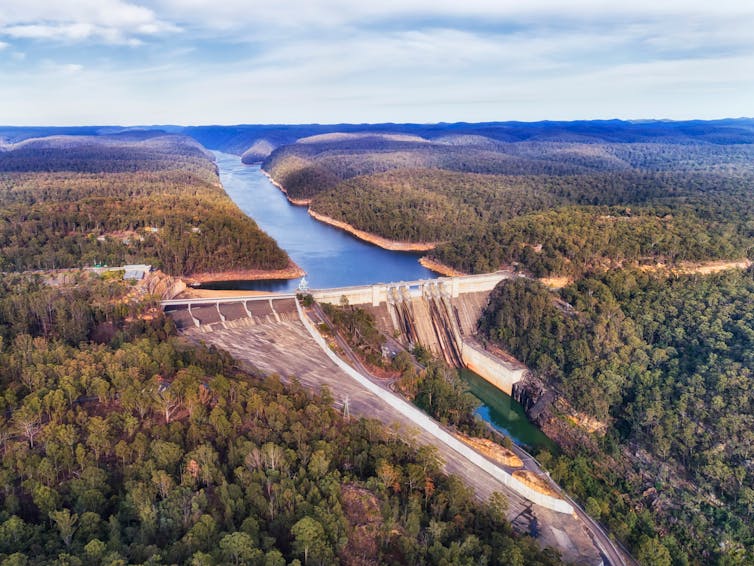
The draft conditions for the expansion, set by DPIE, would not have addressed cumulative impacts before approval was granted.
Several years ago, WaterNSW developed cumulative impact criteria to be applied to mining developments before approval. But the document remains a draft and has not been published, for reasons unknown.
A National Problem
The problems we raise are not isolated to NSW environment law. At a federal level, the Environment Protection and Biodiversity Conservation (EPBC) Act needs an urgent overhaul.
The Morrison government last week released an independent review of the laws by Professor Graeme Samuel. Among the report’s many scathing criticisms were that “cumulative impacts on the environment are not systematically considered”.
Samuel said Commonwealth environment authorities assess development proposals only when they meet certain criteria.
Read more: A major report excoriated Australia's environment laws. Sussan Ley's response is confused and risky
Even when the Commonwealth does scrutinise a proposal, decisions are made only on a project-by-project basis, rather than as part of an “integrated system of environmental management that ensure cumulative impacts are well managed”, Samuel said.
Weaknesses in Australian federal and state laws, and enforcement, often means cumulative effects are not considered on paper or in practice.
For example, the Victorian Auditor-General recently found measures designed to mitigate the cumulative effect of residential developments on Melbourne’s urban fringe were not being implemented.
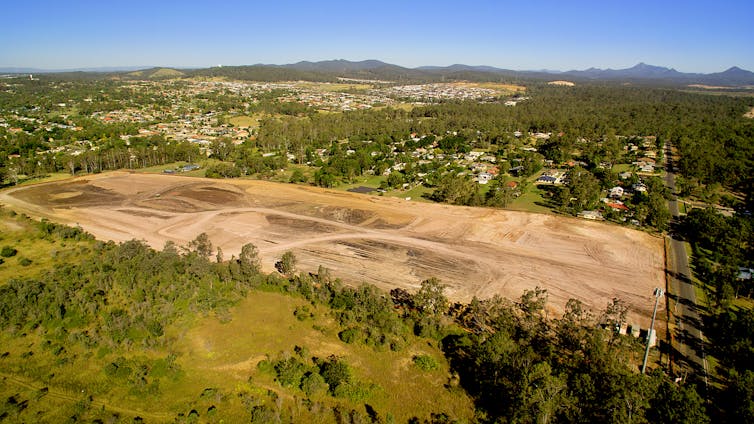
Shoring Up Our Drinking Water
Few environmental problems are more pressing than permanent impacts on a major city’s water supply. But protecting water resources from cumulative harm requires the following
well-defined thresholds, set with rational justification and able to be changed as new information arises
robust measurements to assess if thresholds are being approached or exceeded
clear conditions for developers that require concrete actions if thresholds are crossed
transparency and trust in how the decisions are being made.
Clearly, the law and associated planning processes must consider the accumulating damage stressing the natural world. Otherwise, we may reach irreversible tipping points without even realising it.
Read more: World-first mining standard must protect people and hold powerful companies to account ![]()
Pete Dupen, PhD Student, University of Technology Sydney and Rebecca Louise Nelson, Associate Professor in Law, University of Melbourne
This article is republished from The Conversation under a Creative Commons license. Read the original article.
To fix Australia's environment laws, wildlife experts call for these 4 changes — all are crucial
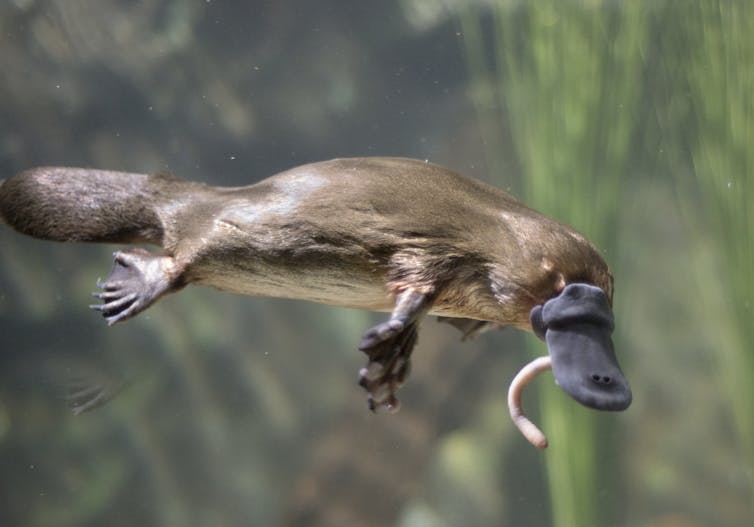
The independent review of Australia’s main environment law, released last week, provided a sobering but accurate appraisal of a dire situation.
The review was led by Professor Graeme Samuel and involved consultation with scientists, legal experts, industry and conservation organisations. Samuel’s report concluded Australia’s biodiversity is in decline and the law (the EPBC Act) “is not fit for current or future environmental challenges”.
The findings are no surprise to us. As ecologists, we’ve seen first hand how Australia’s nature laws and governance failure have permitted environmental degradation and destruction to the point that species face extinction. Even then, continued damage is routinely permitted.
And the findings aren’t news to many other Australians, who have watched wildlife and iconic places such as Kakadu and Kosciuszko national parks, and the Great Barrier Reef, decline at rates that have only accelerated since the act was introduced in 1999. Even globally recognisable wildlife, such as the platypus, now face a future that’s far from certain.
To reverse Australia’s appalling track record of protecting biodiversity, four major reforms recommended by Samuel must be implemented as a package.
1. Setting Standards
One of the many failings of Australia’s environmental laws is there has never been a point beyond which no further impacts are acceptable.
The government almost never says “enough!”, whether it’s undermining wetlands for a new mine, or clearing woodlands for agriculture. Species continue to suffer death by a thousand cuts.
Read more: Death by 775 cuts: how conservation law is failing the black-throated finch
For example, the original distribution of the endangered southern black-throated finch of southern and central Queensland has shrunk to less than 10% due to land clearing and habitat degradation. Yet, further clearing was approved for coal mines, housing developments and sugar cane farms.
Biodiversity offsets, which aim to compensate for environmental damage by improving nature elsewhere, have for the most part been dreadfully ineffective. Instead they have been a tool to facilitate biodiversity loss.

The centre piece of Samuel’s report are proposed new National Environmental Standards. These would provide clear grounds for drawing a line in the sand on environmental damage.
Legal, rigorous enforcement of these standards could turn around Australia’s centuries-long record of destroying its natural heritage, and curb Australia’s appalling extinction rate — while also providing clarity and certainty for business.
Vital features of the standards Samuel recommends include:
avoiding impacts on the critical habitat of threatened species
avoiding impacts that could reduce the abundance of threatened species with already small and declining populations
no net reduction in the population size of critically endangered and endangered species
cumulative impacts must be explicitly considered for threatened species and communities
offsets can only be used as a last resort, not as a routine part of business like they are at the moment.
Under the proposed National Environmental Standards, any new developments would need to be in places where environmental damage is avoided from the outset, with offsets only available if they’re ecologically feasible and effective.
2. Greater Government Accountability
The federal environment minister can make decisions with little requirement to publicly justify them.
In 2014, then environment minister Greg Hunt controversially approved an exemption to the EPBC Act for Western Australia’s shark cull. This was despite evidence the cull wouldn’t make people safer, would harm threatened species and would degrade marine ecosystems. Hunt could shirk the evidence, deny the impacts and make a politically expedient decision, with no mechanisms in place to call him to account.
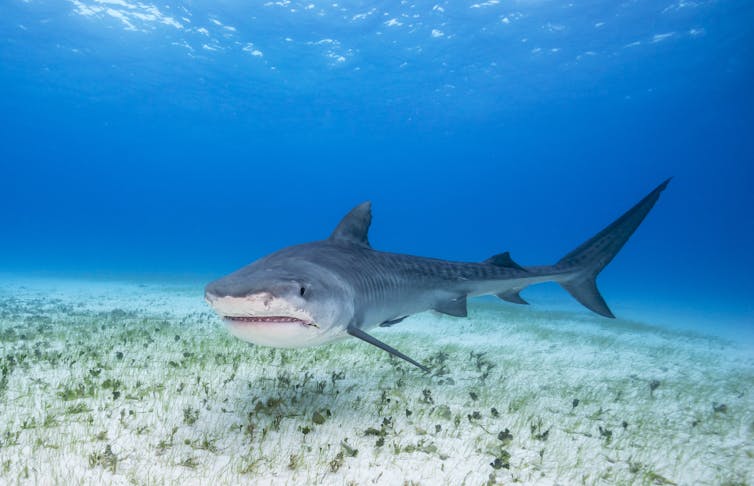
Samuel’s report states the minister can make decisions that aren’t consistent with the National Environmental Standards — but only as a “rare exception”. He says these exceptions must be “demonstrably justified in the public interest”, and this justification must be published.
Read more: Why we're opposing Western Australia's shark cull: scientists
We think this epitomises democracy. Ministers can make decisions, but they must be open to public and robust scrutiny and explain how their decisions might affect environments and species.
Improved accountability will be one of the many benefits of Samuel’s proposed independent Environment Assurance Commissioner, which would be backed up by an Office of Compliance and Enforcement. Samuel says these must be free from political interference.
These are absolutely critical aspects of the reforms. Standards that aren’t audited or enforced are as worthless as an unfunded recovery plan.
3. Decent Funding
Samuel urges improved resourcing because to date, funding to protect species and the environment has been grossly inadequate. For example, experts recently concluded up to 11 reptile species are at risk of extinction in the next 50 years in Australia, and limited funding is a key barrier to taking action.
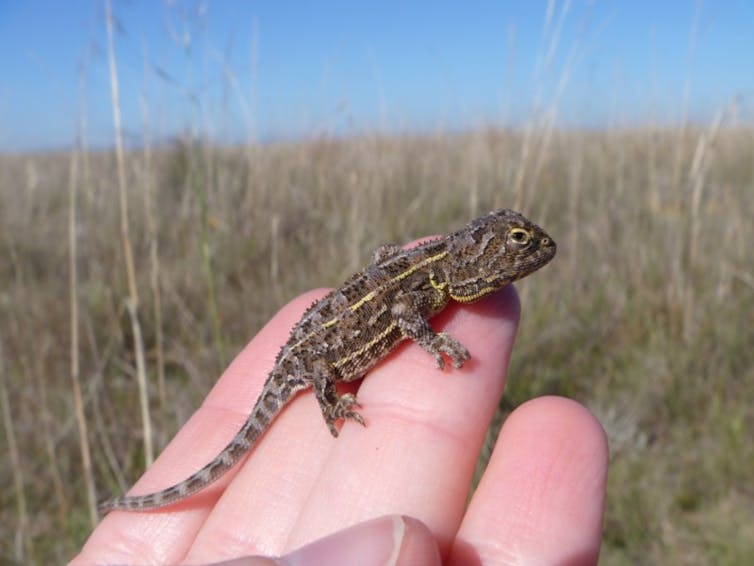
And it has been proven time and again that lack of action due to under-resourcing leads to extinction. The recent extinction of the Christmas Island forest skink, the Christmas Island pipistrelle, and the Bramble Cay melomys were all attributable, in large part, to limited funding, both in the administration of the threatened species listing process, and in delivering urgent on-ground action.
Read more: Vale 'Gump', the last known Christmas Island Forest Skink
We need only look to the COVID pandemic to know when faced with emergencies, the government can rapidly deploy substantial sums of money for urgent interventions. And we are well and truly in an environmental emergency.
Spending to care for the environment is not a cost that delivers no return. It’s an investment that delivers substantial benefits, from creating jobs to cleaner water and healthier people.
4. Increase Ecological Knowledge
Engaging experts is key to achieving Samuel’s long-overdue proposed reforms. He calls for the immediate creation of expert committees on sustainable development, Indigenous participation, conservation science, heritage, and water resources. This will help support the best available data collection to underpin important decisions.
Ultimately, though, much more investment in building ecological knowledge is required.
Australia has more than 1,900 listed threatened species and ecological communities, and most don’t even have active recovery plans. Ecologists will need to collect, analyse and interpret new, up-to-date data to make biodiversity conservation laws operational for most threatened species.
For example, while we know logging and fires threaten greater gliders, there’s still no recovery plan for this iconic forest possum. And recent research suggests there are actually three — not simply one — species of greater glider. Suspected interactions between climate change, fire and logging, and unexplained severe population declines, means significant new effort must be invested to set out a clear plan for their recovery.
Read more: Environment laws have failed to tackle the extinction emergency. Here's the proof
Samuel recommends Regional Recovery Plans be adequately funded to help develop some knowledge. But we suggest substantial new environmental capacity is needed, including new ecological research positions, increased environmental monitoring infrastructure, and appropriate funding of recovery plans, to ensure enough knowledge supports decision making.
Cherry Picking Recommendations Condemns Our Species
Samuel’s report has provided a path forward that could make a substantial difference to Australia’s shocking track record of biodiversity conservation and land stewardship.
But Environment Minister Sussan Ley’s response so far suggests the Morrison government plans to cherry pick from Samuel’s recommendations, and rush through changes without appropriate safeguards.
If the changes we outlined above aren’t implemented as a package, our precious natural heritage will continue to decline.
Read more: A major report excoriated Australia's environment laws. Sussan Ley's response is confused and risky ![]()
Don Driscoll, Professor in Terrestrial Ecology, Deakin University; April Reside, Researcher, Centre for Biodiversity and Conservation Science, The University of Queensland; Brendan Wintle, Professor in Conservation Ecology, School of BioSciences, University of Melbourne; Euan Ritchie, Professor in Wildlife Ecology and Conservation, Centre for Integrative Ecology, School of Life & Environmental Sciences, Deakin University, and Martine Maron, ARC Future Fellow and Professor of Environmental Management, The University of Queensland
This article is republished from The Conversation under a Creative Commons license. Read the original article.
Humans force wild animals into tight spots, or send them far from home. We calculated just how big the impact is
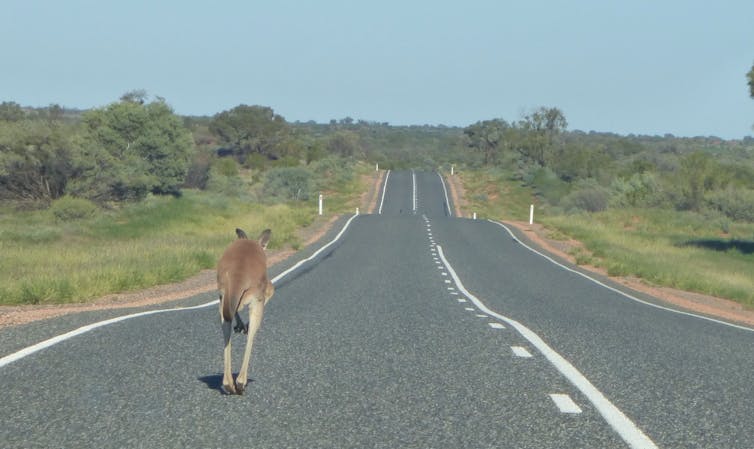
The COVID pandemic has shown us that disruptions to the way we move around, complete daily activities and interact with each other can shatter our wellbeing.
This doesn’t apply only to humans. Wildlife across the globe find themselves in this situation every day, irrespective of a global pandemic.
Our latest research published today in Nature Ecology and Evolution has, for the first time, quantified the repercussions of logging, pollution, hunting, and other human disturbances, on the movements of a wide range of animal species.
Our findings were eye-opening. We found human disturbances, on average, restricted an animal’s movements by 37%, or increased it by 70%. That’s like needing to travel an extra 11 km to get to work each day (Australia’s average is 16 km).
Disruptions Cascade Through The Ecosystem
The ability to travel is essential to animal survival because it allows animals to find mates, food and shelter, escape predators and competitors, and avoid disturbances and threats.
And because animal movement is linked to many important ecological processes — such as pollination, seed dispersal and soil turnover — disruptions to movement can cascade through ecosystems.
Our study involved analysing published data on changes in animal movement in response to different types of disturbance or habitat modification by humans. This included agriculture, logging, grazing, recreation, hunting, and pollution, amongst others.
All up, we looked at 719 records of animal movement, spanning 208 studies and 167 species of birds, mammals, reptiles, fish, insects and amphibians. The size of the species we studied ranged from the sleepy orange butterfly to the white shark.
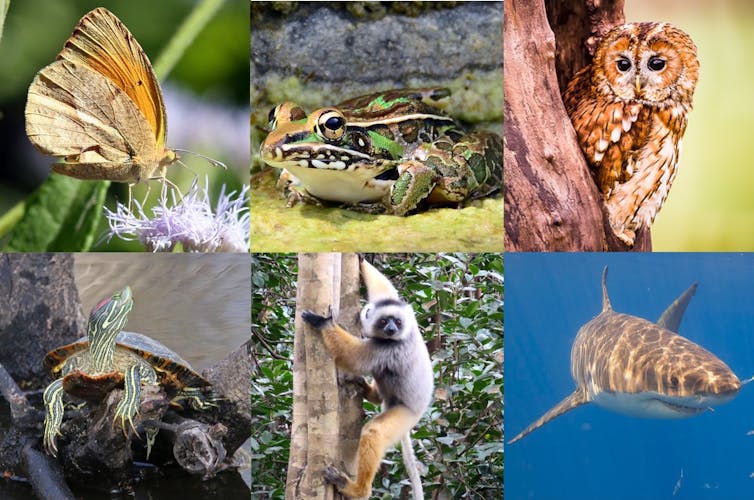
What We Found
We found changes in movement are very common, with two-thirds of the 719 cases comprising an increase or decrease in movement of 20% or more. More than one-third of cases changed by 50% or more.
Whether an animal increases or decreases its movement in response to disturbance from humans depends on the situation.
Animals may run away from humans, or move further in search of food and nesting sites. For example, a 2020 study on koalas found their movements were longer and more directed in areas where habitats weren’t well connected, because they had to travel further to reach food patches.
Likewise, the daily movement distances of mountain brushtail possums in central Victoria were 57% higher in remnant bushland along roadsides, compared to large forest areas.
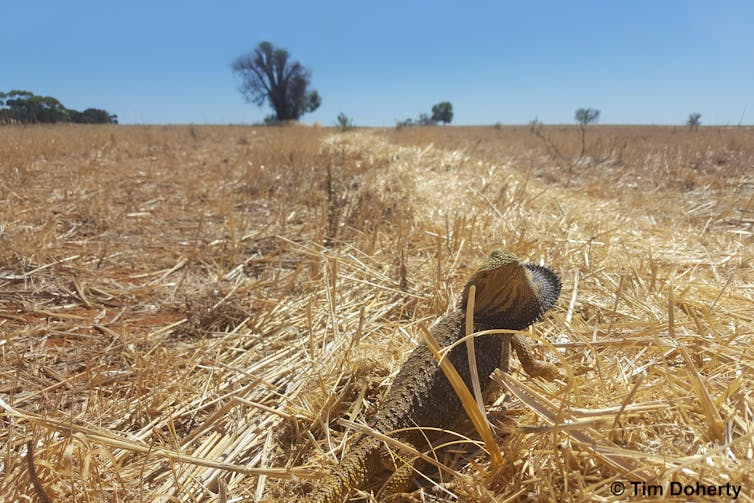
Decreases in movement can occur where animals encounter barriers (such as highways), if they need to shelter from a disturbance, or can’t move as efficiently through altered habitats. In the United States, for example, researchers played a recording of humans talking and found it caused a 34% decrease in the speed that mountain lions move.
On the other hand, some decreases in movement occur where an animal actually benefits from habitat changes. A wide range of animals — including storks, vultures, crows, foxes, mongooses, hyenas and monitor lizards — have shorter movements around garbage dumps because they don’t have to move very far to get the food they need.
Huge Changes In Movement Make Animals Vulnerable
Overall, we found the average increase in animal movement was +70% and the average decrease was -37%, which are substantial changes.
Imagine having to increase the distance you travel to work, the shops and to see family and friends, by 70%. You would spend a lot more time and energy travelling and have less time to rest or do fun things. And if you live in Melbourne, you know what substantial reductions in movement are like due to COVID-related lockdowns.
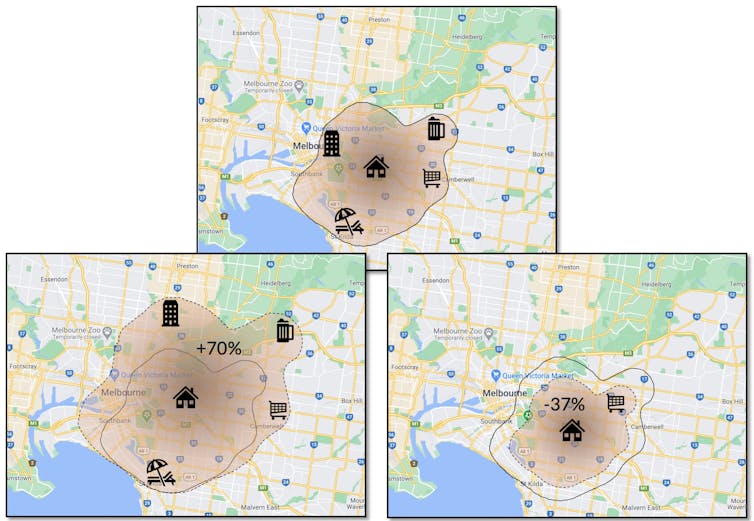
In addition to greater energy expenditure, increased movements can mean animals need to move through risky areas where they are more vulnerable to predation.
And decreases in movement can be harmful if animals can’t find adequate food or disperse to find mates, or if ecological processes such as seed dispersal are disrupted.
Read more: Predators, prey and moonlight singing: how phases of the Moon affect native wildlife
For example, flightless rails, birds native to New Zealand, are important for dispersing seeds. But research showed birds in areas of high human activity (campgrounds) moved 35–41% shorter distances than birds away from campgrounds. This could limit the population growth of plants if their seeds are not being dispersed as far.
When Disturbances Are Unpredictable
We compared the effects of different disturbance types on animals by splitting them into two categories: human activities (such as hunting, military procedures and recreation like tourism) and habitat modification (such as agriculture and logging).
Both disturbance types can have severe impacts, ranging from a 90% decrease to 1,800% increase in movement for human activities, and a 97% decrease to a 3,300% increase for habitat modifications.
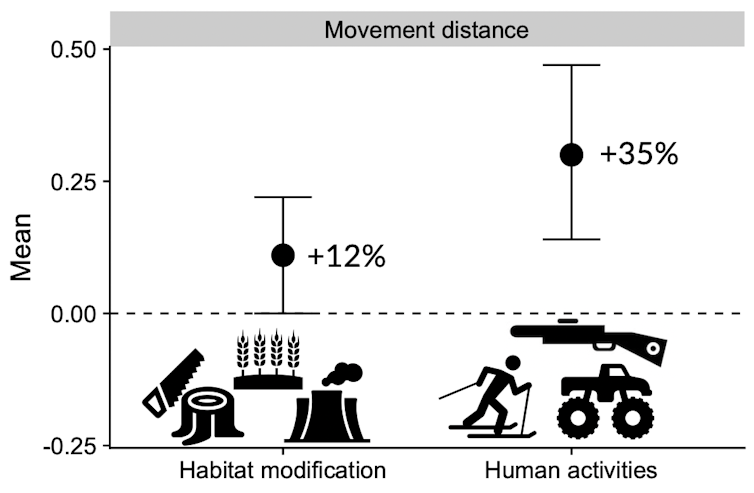
But we found human activities caused much stronger increases in animal movement distances (averaging +35%) than habitat modifications (averaging +12%).
This might be because human activities are more episodic in nature. In other words, animals are more likely to run away from these unpredictable disturbances.
Read more: Be still, my beating wings: hunters kill migrating birds on their 10,000km journey to Australia
For example, military manoeuvres in Norway led to 84% increase in the home range of moose. And when moose in Sweden were exposed to back-country skiers, their movement speed increased 33-fold.
In contrast, habitat modifications like logging generally represent more persistent changes to the environment, which animals can sometimes adapt to over time.
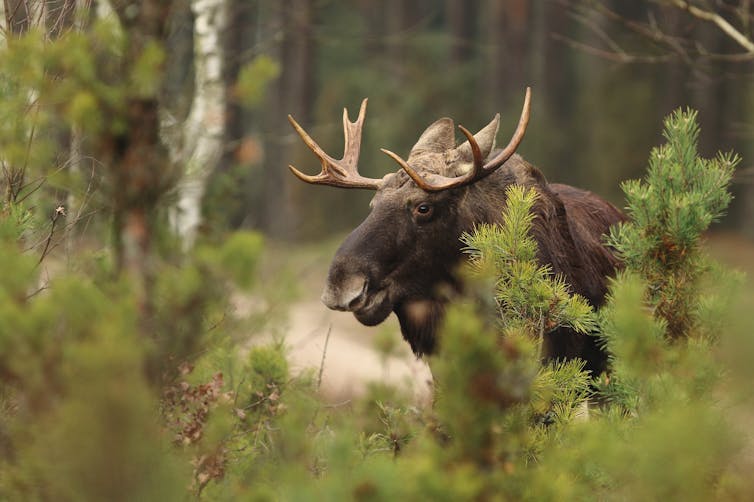
Reducing Harms On Wildlife
To reduce the harms we inflict on wildlife, we must protect habitats in relatively intact sea and landscapes from getting degraded or transformed. This could include establishing and managing new national parks and marine protected areas.
Where ecosystems are already modified, improving the connections between habitats and the availability of resources (food and water) can help animals move more easily and populations persist.
And with regards to human activities, which generally caused stronger increases in movement, better managing disturbances such as hunting, recreation and tourism can help to minimise or avoid impacts on animal movement. This could include, for example, establishing a no-take zone in a marine protected area, or enforcing restrictions to activities during breeding periods.
Tim Doherty, ARC DECRA Fellow, University of Sydney; Don Driscoll, Professor in Terrestrial Ecology, Deakin University, and Graeme Hays, Professor of Marine Science, Deakin University
This article is republished from The Conversation under a Creative Commons license. Read the original article.
Greta Thunberg effect: people familiar with young climate activist may be more likely to act
Anandita Sabherwal, London School of Economics and Political Science and Sander van der Linden, University of CambridgeShe was declared Time magazine’s person of the year in the same month that Donald Trump told her to “work on her anger management issues”. Greta Thunberg has attracted international attention since her lone demonstration outside the Swedish Parliament in August 2018. Her “school strike for the climate” has now grown into a global movement that has brought more than 10 million people onto streets worldwide to demand action on climate change.
In the same time that Greta Thunberg has become a household name, public concern about climate change has reached record highs in the US. But what role has Thunberg’s personal influence played in this? Do her speeches appeal to diverse audiences or is she simply preaching to the choir?
Based on a nationally representative survey of over 1,300 US adults, our study found that Americans who report being more familiar with Greta Thunberg also feel more confident that they can help mitigate climate change as part of a collective effort. They are also more willing to take action themselves, by contacting elected officials or giving time and money to campaigns. We call this the Greta Thunberg effect.
Familiarity Breeds Empowerment
Seeing or hearing Greta Thunberg once doesn’t instantly turn someone into a climate activist. Nonetheless, we discovered a potentially important pattern of associations. Those more familiar with Thunberg were more likely to think their actions were effective and meaningful and were more intent on doing something about climate change. Our model seemed to show this might be the case because people who knew Thunberg’s story – how her lonely stand inspired millions around the world to join her – were more likely to recognise the potential for ordinary people to make a difference.
We wanted to know how widespread this effect might be, so we tried to find out which audiences Thunberg most appealed to. In her public appearances, she’s often surrounded by young people and her demands for climate action align most strongly with liberal policy preferences. Since people tend to listen more to those they identify with, we thought that young and left-leaning people would be more strongly influenced by her.
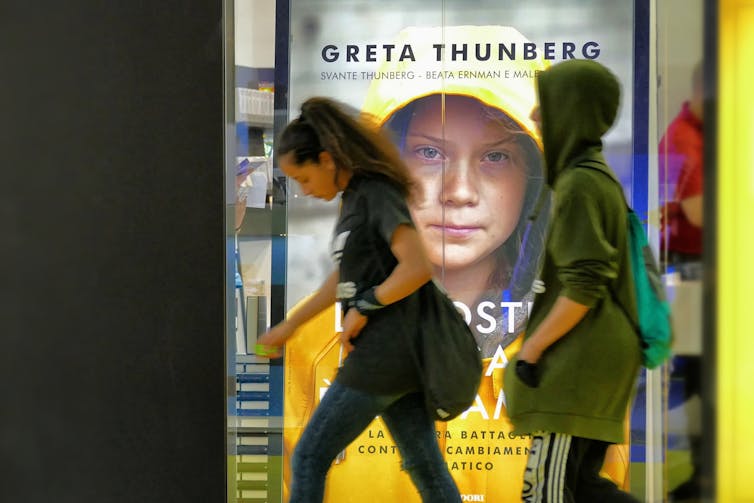
Surprisingly, the Greta Thunberg effect seems to be similar across age groups and the political spectrum for US adults, though it was stronger among liberals than conservatives. We didn’t survey children and teenagers, but we expect them to be most strongly influenced by Thunberg’s school strikes.
‘No One Is Too Small To Make A Difference’
Pope Francis, James Hansen and Jeff Bezos have all tried to spur momentum on climate action using their religious, academic and financial authority. Greta Thunberg lacks any such elite status, so how has she been able to succeed?
Given the prevailing sense of doom about climate change, empowering people to take action requires an ability to convey that change is possible. In her speeches, Thunberg proclaims that “there is still time to change everything around”. Her Fridays for Future campaign is also founded on the empowering message that anyone – even school students – can make a difference.
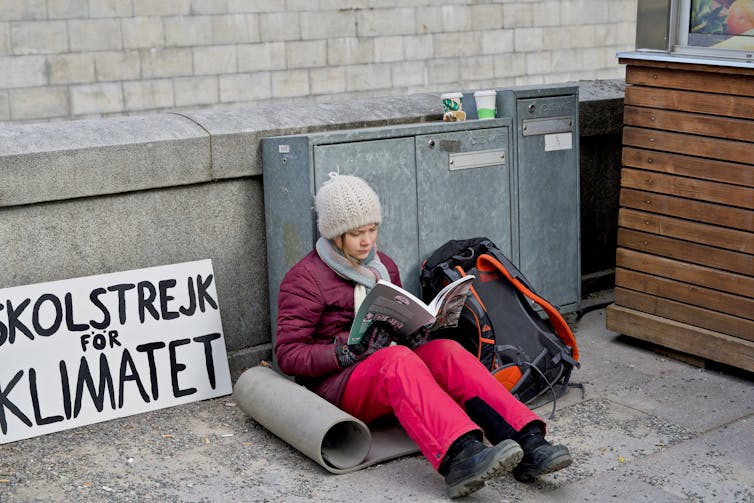
Most importantly, Thunberg’s actions are consistent with her words. Her fiery demands to world leaders, whether at the United Nations or the US Congress demonstrate that anyone can – and should – challenge powerful institutions and people.
What Does This Mean For Climate Action?
How can we be sure that our findings reflect Greta Thunberg’s own effect and not the influence of climate activism more generally? The short answer is that we can’t. But to help isolate Thunberg’s influence, we asked our study participants to rate their support for climate activism and found that familiarity with Thunberg remained relevant even when controlling for this.
Of course, there are other things that could explain why people may want to take action on climate change, such as their prior support for environmental reform or their having heard about climate change in the news. But much of this is already captured indirectly by political ideology in our model, which is one of the most important predictors of what a person reads and how much they support climate action. So, while there are many reasons people might want to tackle climate change, being familiar with Greta Thunberg appears to have a unique influence on the extent to which they feel empowered to make a difference.

But what if the Greta Thunberg effect is actually operating the other way? Did we instead find that people who are already more likely to act on climate change are just more familiar with Greta Thunberg? We can’t be certain because this type of study can’t prove cause and effect, it can only show associations. But statistical tests showed that this reverse explanation did not explain the data as well as our original one. Of course, reality may be more complex than what our models can capture. A positive feedback loop – where both explanations operate in tandem to inspire climate action – is also possible.
Future research can build on our findings using controlled experiments, but the patterns in our data at least suggest that Greta Thunberg is a particularly inspirational leader in part because she’s a convincing example that sudden, big change is possible. Now, how can activists amplify their own impact? Considering how politicised climate change is, one answer might be appealing to people across the political spectrum by highlighting aspects of their identity that they tend to share with the wider public. The Greta Thunberg effect suggests that calls to action may be able to mobilise broad segments of society, regardless of age or politics.![]()
Anandita Sabherwal, PhD Student in Psychological and Behavioural Science, London School of Economics and Political Science and Sander van der Linden, Professor of Social Psychology in Society and Director, Cambridge Social Decision-Making Lab, University of Cambridge
This article is republished from The Conversation under a Creative Commons license. Read the original article.
What The Flora!? Episode 1 - Bushfires: Pushing Plants To Extinction
Published by the Royal Botanic Garden Sydney, January 2021
Last summer, about 7 billion trees were impacted by the bushfires in Australia. Join your host Vanessa Fuchs and Chief Botanist Dr Brett Summerell and discover how scientists at the Australian Institute of Botanical Science are using seed-banking to guard our endangered native plant species against extinction.
 Shorebird Identification Booklet
Shorebird Identification Booklet
The Migratory Shorebird Program has just released the third edition of its hugely popular Shorebird Identification Booklet. The team has thoroughly revised and updated this pocket-sized companion for all shorebird counters and interested birders, with lots of useful information on our most common shorebirds, key identification features, sighting distribution maps and short articles on some of BirdLife’s shorebird activities.
The booklet can be downloaded here in PDF file format: http://www.birdlife.org.au/documents/Shorebird_ID_Booklet_V3.pdf
Paper copies can be ordered as well, see http://www.birdlife.org.au/projects/shorebirds-2020/counter-resources for details.
Download BirdLife Australia's children’s education kit to help them learn more about our wading birdlife
Shorebirds are a group of wading birds that can be found feeding on swamps, tidal mudflats, estuaries, beaches and open country. For many people, shorebirds are just those brown birds feeding a long way out on the mud but they are actually a remarkably diverse collection of birds including stilts, sandpipers, snipe, curlews, godwits, plovers and oystercatchers. Each species is superbly adapted to suit its preferred habitat. The Red-necked Stint is as small as a sparrow, with relatively short legs and bill that it pecks food from the surface of the mud with, whereas the Eastern Curlew is over two feet long with a exceptionally long legs and a massively curved beak that it thrusts deep down into the mud to pull out crabs, worms and other creatures hidden below the surface.
Some shorebirds are fairly drab in plumage, especially when they are visiting Australia in their non-breeding season, but when they migrate to their Arctic nesting grounds, they develop a vibrant flush of bright colours to attract a mate. We have 37 types of shorebirds that annually migrate to Australia on some of the most lengthy and arduous journeys in the animal kingdom, but there are also 18 shorebirds that call Australia home all year round.
What all our shorebirds have in common—be they large or small, seasoned traveller or homebody, brightly coloured or in muted tones—is that each species needs adequate safe areas where they can successfully feed and breed.
The National Shorebird Monitoring Program is managed and supported by BirdLife Australia.
This project is supported by Glenelg Hopkins Catchment Management Authority and Hunter Local Land Services through funding from the Australian Government’s National Landcare Program. Funding from Helen Macpherson Smith Trust and Port Phillip Bay Fund is acknowledged.
The National Shorebird Monitoring Program is made possible with the help of over 1,600 volunteers working in coastal and inland habitats all over Australia.
The National Shorebird Monitoring program (started as the Shorebirds 2020 project initiated to re-invigorate monitoring around Australia) is raising awareness of how incredible shorebirds are, and actively engaging the community to participate in gathering information needed to conserve shorebirds.
In the short term, the destruction of tidal ecosystems will need to be stopped, and our program is designed to strengthen the case for protecting these important habitats.
In the long term, there will be a need to mitigate against the likely effects of climate change on a species that travels across the entire range of latitudes where impacts are likely.
The identification and protection of critical areas for shorebirds will need to continue in order to guard against the potential threats associated with habitats in close proximity to nearly half the human population.
Here in Australia, the place where these birds grow up and spend most of their lives, continued monitoring is necessary to inform the best management practice to maintain shorebird populations.
BirdLife Australia believe that we can help secure a brighter future for these remarkable birds by educating stakeholders, gathering information on how and why shorebird populations are changing, and working to grow the community of people who care about shorebirds.
To find out more visit: http://www.birdlife.org.au/projects/shorebirds-2020/shorebirds-2020-program
Aussie Bread Tags Collection Points

Changes To NSW Retirement Village Laws Commence In 2021
Proposed changes to commence early 2021
New retirement village laws start in 2021. They deliver on a NSW Government election commitment that includes:
- enabling residents to receive exit entitlement money before their unit sells (if the sale has been ‘unreasonably delayed’)
- providing an option for residents to fund their move into aged care by accessing part of their estimated exit entitlement money
- ensuring residents no longer have to pay ongoing charges for general services 42 days after they leave the retirement village (from the start of the first financial year that applies to their village that commences on 1 July 2021 onwards).
The new laws will:
- apply only to registered interest holders with a long-term registered lease that gives them at least 50% of any capital gain.
not apply to:
- unregistered interest holders
- registered interest holders who own a lot in a strata or community scheme village or own shares in a company title village that gives them their resident right.
A resident can check their retirement village contract to confirm which arrangement they have.
The following information outlines the key changes under the Retirement Villages Amendment Act 2020. This information will be updated in early 2021 when the supporting Regulations are completed.
Residents’ right to access exit entitlement money
An exit entitlement is paid to an outgoing resident when they permanently leave a retirement village.
Permanent vacation includes the removal of all possessions from the property and handing back the keys to the operator. The amount paid depends on the terms of each resident’s contract.
From 1 January 2021, a resident will gain the right to apply for an order to receive their calculated exit entitlement, if their unit remains unsold after:
- 6 months in the metropolitan area (local government areas will be listed in the Regulation), or
- 12 months in other areas.
The time for the prescribed period starts 40 days after (whichever occurs first):
- the date the property is first advertised for sale
- the date the resident permanently vacates the property, including returning all keys to the property to the operator
- if the resident doesn't intend to move out of the property while it is for sale, the date the resident gives written notice to the operator of their intention to stay in the property while it is for sale.
Note: the prescribed period doesn’t apply to a former resident who has been paid part of their exit entitlement by way of accommodation payments for aged care, provided their premises have not sold within 2 years after the resident has first entered the aged care facility.
This means the first residents will be able to apply for such orders from 1 August 2021. This takes into account the 6 month period the property has remained unsold (if in a metropolitan area) and the 40 day notice period the resident must provide to the operator about their intention to apply for an order. This right also applies to former residents who have had their property for sale before 1 January 2021.
To calculate the exit entitlement, the estimated sale price for the property and any capital gain must be worked out by:
- an independent property valuer, or
- the outgoing resident and operator agreeing to its value.
If a resident makes an application to the Secretary for an order, the village operator must satisfy the Secretary that they have not ‘unreasonably delayed’ the sale of the property:
- If the operator can’t, the Secretary will issue an order to the operator to pay the resident their exit entitlement money.
- If the operator satisfies the Secretary that they have not unreasonably delayed the sale, then the Secretary will not issue an order and will notify both parties of this decision as soon as possible.
The operator can apply to the Secretary for an order to extend the 6 or 12 month period with respect to a property. To gain the extension of time, the operator must satisfy the Secretary that they have not unreasonably delayed the sale of the property (during the time period reviewed).
Timeframe for paying an exit entitlement if a property sells
Registered interest holders must be paid their exit entitlement after their property sells. These existing requirements will still apply if a property actually sells. This is already a requirement under existing retirement village laws. For whichever happens first, the operator must make the exit entitlement payment within 14 days after the date they:
- enter into a village contract with a new incoming resident to the property
- receive full payment under a contract from a new incoming resident to the property
- enter into a residential tenancy agreement with a new incoming tenant to the property, or
- allow someone to start living in the property.
Supporting the transition to aged care
More than 60 per cent of village residents move directly into aged care. Previously, this move could be delayed if residents didn’t have the money available to cover the costs of moving.
From 1 January 2021, if a village resident needs to move to an aged care facility, the village operator must pay using the prescribed component of the resident’s calculated exit entitlement (not including any capital gain), at the resident requests. This will be paid to the resident’s nominated aged care provider as the Daily Accommodation Payment (DAP). Operators must pay up to 85 per cent of the prescribed component as the DAP.
Operators will be able to apply to the Tribunal to:
- extend the time for paying the accommodation payment, or
- not pay the accommodation payment to an aged care facility.
The Tribunal may make an order only if satisfied that making an accommodation payment would impose a significant financial burden on the operator. The Tribunal will consider the outgoing resident and operator’s views and circumstances to make its decision.
Residents in an aged care facility having their accommodation payments paid by the operator as a DAP, can also request an exit entitlement order after 2 years from the date of entering the facility, if their premises has not sold.
Residents entering an aged care facility before 1 January 2021:
- cannot request the accommodation payments; but
- may still apply for early exit entitlement payments at the relevant 6 or 12-month timeframe after the 1 January 2021 start date, if their unit is not sold.
42-day cap on recurrent charges for general services
Village operators will only be able to charge residents for up to 42 days for general services (gardening, administration, cleaning, etc.) once they have permanently left the property. This will apply to residents on or after 1 July 2021, when their village’s financial year commences.
This new provision only applies to residents whose contract is in the form of a long-term registered lease that entitles them to at least 50 per cent of any capital gain. Unregistered interest holders still have access to their 42-day cap. The new 42-day cap provision does not apply to residents who own a lot in strata, or community villages or own shares in company title villages that give them a residence right.
Between 1 January 2021 and 1 July 2021 only, a current resident who has moved out, can ask the operator to deduct these charges from their exit entitlement. The operator must action these payment, within 14 days after the request is made. This provision will apply to residents in a village when their financial year commences on or after 1 July 2021.
Proposed changes to commence early 2021
Asset management plans
Changes will come into effect in early 2021. Once the amendments to the Retirement Villages Regulation are made, operators will have to maintain an asset management plan for the village’s capital items. They must make the plan available to current and prospective residents.
The asset management plan must include:
- costs associated with maintaining and replacing items of capital
- reasons for decreases or increases in costs
- how often costs are incurred and the expected lifespans of items
- maintenance and replacement requirements of items of capital.
To allow time for operators to prepare the asset management plans and fully comply with this requirement, penalty provisions for non-compliance will not commence until the second half of 2021.
Changes already implemented
Following consultation, the government previously implemented the following reforms.
Annual contract ‘check-up’ meetings
Residents have the right to meet with their village operator once a year to discuss their contract and get a better understanding of the process involved when leaving the village, including any fees and charges payable.
Family, friends or advisors may attend the meeting with the resident to give them support or assistance. Residents may also nominate one or more people to represent them at the meeting if they cannot attend.
At the meeting, operators need to provide a verbal and written summary of all costs incurred if the resident were to leave the village. This is based on the terms and conditions of the resident’s contract. This tailored information will help residents better understand what’s involved when leaving the village and allow any concerns or questions to be addressed.
The following information must be provided at the meeting:
- a resident’s rights and obligations in relation to leaving the village
- estimated departure fee (if applicable)
- estimated fees and charges involved with selling the unit
- estimated sale price or estimated ingoing contribution of the next resident, as applicable to the resident’s contract
- estimates of any other fees or charges that apply when leaving the village (including an estimate of any capital gain shared with the operator)
- how long recurrent charges may be payable after leaving the village
- estimate of the final monies a resident would receive upon leaving the village, after they have paid all fees and charges.
Any cost and other estimates provided by the operator at the meeting must be reasonable. They must take into consideration factors that may influence the estimate, such as the features and characteristics of the resident’s unit. A reasonable estimate will ultimately depend on the circumstances of each resident.
Significant penalties can apply for operators who provide unreasonable estimates.
Further information can be found in the Village contract information meetings guideline.
Emergency plans, evacuation exercises and safety information
Operators are required to prepare and maintain an emergency plan for their village. They must ensure that residents and staff are familiar with the plan.
The emergency plan should be easy to understand and tailored to the village. It must be tailored to the factors that may affect the response to an emergency in the village, including:
- the size, location and layout of the village
- the number of residents in the village
- the needs of residents with mobility, hearing, visual or other impairments.
The operator must review their emergency plan at least every 12 months.
At least once a year, operators must carry out an evacuation exercise. They are responsible for making sure that all residents are familiar with emergency protocols and can safely evacuate, if they need to.
While operators can't force residents to participate in annual evacuation exercises, they should actively promote participation. The greater the participation, the more prepared the village will be in an emergency.
Operators must also display key safety information in communal areas within the retirement village, including:
- a map showing the location of assembly areas, exits, fire extinguishers and any other emergency equipment
- instructions on how to evacuate in the event of a fire or other emergency
Operators must provide this information to each resident, tailored to their specific unit in the village.
These obligations respond to the concerns of many residents raised during the Inquiry.
To learn more, refer to the Emergency plans and evacuation exercises guideline.
Appointing an auditor
Operators must obtain residents’ consent each year before appointing an auditor of the accounts of the retirement village.
For most villages, approval of the auditor will be sought at the same time as the village budget.
Where residents do not agree with the auditor the operator suggests, they may put forward an alternative. This gives residents a say in who examines how the operator is using the money that residents pay as recurrent charges.
Where the operator does not agree with the alternative auditor put forward by the residents, the operator will need to apply to the Tribunal for an order. The Tribunal cannot make an order in the operator’s favour, unless it considers there are exceptional circumstances for doing so.
You can find out more in the Annual auditing of accounts guideline.
Rules of conduct
On 1 July 2019, rules of conduct came into effect under the Retirement Villages Amendment (Rules of Conduct) Regulation 2018.
The rules of conduct prescribe mandatory minimum standards for operators, which concern their:
- knowledge of legislation
- conduct when dealing with prospective and current residents
- honesty and ethics when marketing retirement villages
- ways to solve disputes and handle complaints within their village
- reporting and management of conflicts of interest
- training and skills (including that of their staff)
- interactions with external selling agents when selling a residence.
The rules of conduct are enforceable and significant penalties may apply if operators fail to comply.
Free on-site mediation
The reforms provide new regulatory powers relating to mediating retirement village disputes. This includes the power to prescribe circumstances where mediation will be a mandatory step before progressing to the NSW Civil and Administrative Tribunal (NCAT).
Find out more about retirement village disputes.
The inquiry that led to these changes
As part of its four-point plan to improve retirement village living, the NSW Government commissioned Kathryn Greiner AO to lead an Inquiry into the state’s retirement village sector. It was completed between August and December 2017.
This Inquiry found that the operation of the retirement village sector could be improved in three key areas:
- increasing transparency of exit fees and contracts
- clarifying the funding arrangements for ongoing maintenance costs which are shared between residents and operators
- providing more support when disputes arise (and reducing the potential for disputes to arise).
Kathryn Greiner was appointed as the NSW Government’s inaugural Retirement Village Ambassador. She travelled the state talking to residents and prospective residents about their rights and retirement village living.
Since the launch of the program in December 2018, the Retirement Village Ambassador presented to more than 4,600 residents of retirement villages and prospective residents. This included a series of public forums held around the state, which helped raise awareness about changes to retirement village laws.
Due to COVID-19, the Retirement Village Ambassador Program has been placed on hold for 2021.
ARTEXPRESS At The Art Gallery Of NSW Opened This Week
Runs: 4 Feb – 5 Apr 2021
Free admission
Location: Major exhibition gallery
ARTEXPRESS 2021
Celebrating Resilience
The Art Gallery of New South Wales is proud to present ARTEXPRESS 2021, celebrating the next generation of Australian artists and showcasing outstanding works of art created by NSW students who overcame many hurdles to complete the Higher School Certificate (HSC) Visual Arts examination in 2020.
The exhibition at the Gallery features 48 artworks selected from 8617 student works submitted for the 2020 HSC, including works by students from government and non-government schools from across metropolitan and regional NSW.
Art Gallery of NSW director Dr Michael Brand said the Gallery is proud to present the 37th annual ARTEXPRESS and commends the Class of 2020 for their perseverance.
“I congratulate all 2020 HSC Visual Arts students on the outstanding accomplishment of creating their body of artwork, during one of the most challenging years on record,” said Brand.
“Creative pursuits can provide great comfort in difficult times and it is our hope that this year’s cohort found solace in their artmaking, as well as a sense of defiance.
“The high standard of work on show is a testament to the tremendous talent and resilience of students and teachers in NSW who adapted to change and overcame challenges – from bushfires to the pandemic – to complete their studies.
“We are delighted to share their work with the thousands of visitors who look forward to this annual exhibition, which has become one of our most popular.”
The exceptional bodies of work represent a broad range of approaches across a range of art forms, including painting, drawing, photo-media, sculpture, ceramics, time-based works, documented form, printmaking, textiles and fibre and graphic design, along with a selection of visual arts process diaries (VAPDs) from exhibiting students in ARTEXPRESS. These offer an insight into the way individual students process and develop ideas for final bodies of work.
The whole ARTEXPRESS 2021 is just brilliant. Well worth a visit when you're next in town. If you can't get there, you can have a look via the pages linked to here - not the same as immersing yourself by being in front and around these works, however, check them out - an amazing array of subjects and employed mediums emerging from these Artists.
Manly's Art Gallery and Museum launches its ArtExpress 2021 showcase on February 18th, details below.
Art Gallery of NSW curator of ARTEXPRESS 2021 Louise Halpin said this year’s exhibition offers an insight into the hearts and minds of young people during a very difficult year.
“ARTEXPRESS 2021 is a showcase of extraordinary bodies of work exploring a range of both global and deeply personal themes – from the environment, urban life and beauty of the natural world to identity, relationships and reflection on the 2020 experience,” said Halpin.
The exhibition began in Sydney in the late 1950s and has been exhibited at the Art Gallery of NSW since 1983. Accomplished artists who have previously been selected for exhibition prestigious include Ben Quilty (1992), David Griggs (1994), McLean Edwards (1990), Melissa Chiu (1990) and Jasper Knight (1996).
Among the Artist works featured this year are those of Beilei Liang of Northern Beaches Secondary College, Mackellar Girls Campus and Shariah Cummings, Northern Beaches Secondary College, Freshwater Senior Campus.
One sample each of their works as part of ARTEXPRESS2021 at the Art Gallery of NSW:
Beilei Liang, Northern Beaches Secondary College, Mackellar Girls Campus
Artwork title: 雾 (wù) – [fog]
Expressive form: Collection of works
Artist’s statement
Exposure to other cultures gradually erases one’s original identity. My body of work represents the effects of air pollution, referencing aerial shots of smog over Beijing in 2015. This smog affected the life of Beijing’s people, including my family, so we chose to leave China. Ironically, due to human activities, the quality of Australia’s atmosphere has also decreased. Using the westernised medium of oil paint and charcoal blended with water to form the effect of a traditional Chinese ink painting, I have created a blurred, abstracted atmosphere, like my fading memory and distance from the life I would have known.
Influencing artists: Adriane Strampp, Yang Yongliang, Xu Bing, Melinda Hunt

Beilei Liang, Northern Beaches Secondary College, Mackellar Girls Campus, © the artist. Photo: Robert Edwards
Shariah Cummings, Northern Beaches Secondary College, Freshwater Senior Campus.
Artwork title: 'Those Who Favour Fire'
Expressive form: Painting
Artist’s statement
My body of work, Those Who Favour Fire, represents the Australian bushfires that plagued the nation during late 2019 to early 2020. It acknowledges the fine line between the destructive nature of the blazes and their tragic beauty. My artistic intent in using acrylics in such a small scale was to explore the sensitive technicality required to create a range of atmospheric landscape paintings.
Influencing artist: Robert Frost

Shariah Cummings, Northern Beaches Secondary College, Freshwater Senior Campus,© the artist. Photo: Robert Edwards
ARTEXPRESS is a joint partnership between the NSW Education Standards Authority and NSW Department of Education in association with the principal venue the Art Gallery of New South Wales.
The Art Gallery of New South Wales is open. They are observing strict physical distancing and hygiene measures to protect the health of visitors and staff and minimise the spread of COVID-19 (coronavirus). Read the latest visit information, including hours
UMBRELLA | Award-Winning And Oscar®-Contending Animated Short Film
Premiered on January 8, 2021
Inspired by true events and filled with messages of empathy and hope, Umbrella follows Joseph's story, a boy who lives in an orphanage and dreams of having a yellow Umbrella.
2021 Oscar® Qualified Animated Short Film - For Your Consideration
Like us on Facebook at facebook.com/umbrellaanimatedshort/
Follow us on Instagram: instagram.com/umbrellaanimatedshort
Website: www.umbrella.movie
Carve Out A Career In Stonemasonry
February 2, 2021
TAFE NSW has responded to industry calls for skilled stonemasons after the trade has experienced a skills shortage for more than six consecutive years.
TAFE NSW Miller is offering a Certificate III in Stonemasonry in 2021 to help students learn the hands-on skills in the highly-specialised and timeless trade.
As the only Registered Training Organisation in NSW to deliver stonemasonry courses, TAFE NSW Miller has attracted students from all over the state to study in the state-of-the-art stonemason and bricklaying facility.
TAFE NSW Head Teacher in Stonemasonry, Michael Landers (pictured below), said now was a great time to become an apprentice with the NSW Government subsidising the cost of training under their Fee Free Apprenticeship Initiative.
Mr Landers started an apprenticeship in the trade in 1989, where he became the only registered stonemason in NSW. He has since worked on major projects including the restoration of St Mary’s Cathedral and a commissioned Coat Of Arms for the Governor General, as well as helped develop the state’s first stonemasonry course.
“There has never been a better time to start a stonemasonry apprenticeship, particularly with industry crying out for skilled workers. I’ve never had a past student tell me they can’t find work,” Mr Landers said.
“Stonemasonry is very much an artisan trade requiring delicate hands-on skills but it has also evolved and become dynamic to incorporate cutting-edge technology as demand for stoneworks increases.”
Mr Landers said stonemasonry is an undying trade that will always be required.
“Whether its restoring old heritage buildings, building a fireplace in a new home or carving out a tombstone in cemeteries, there is always ongoing work making stonemasonry a timeless trade,” Mr Landers said.
To enrol in a stonemasonry course at TAFE NSW, visit www.tafensw.edu.au, or call 131 601
TAFE NSW Miller is a quiet and relaxed campus located on Hoxton Park Road, just off the M7 in Sydney's south west. With facilities designed to simulate real-world situations and working environments, TAFE NSW Miller provides students with the opportunity to apply their skills in a practical way, such as the Building and Construction Faculty, which features beautiful timber panelling, stained glass windows and painted ceiling rosettes that have all been skilfully restored by talented TAFE NSW students.
Picture: TAFE NSW stonemasonry teacher Michael Landers
Students And Apprentices Urged To Claim For 2021
Following a difficult 2020 aspiring students and apprentices are encouraged to make the most of the Australian Government’s supports in 2021 and claim for Youth Allowance, ABSTUDY or Austudy now.
Minister for Government Services Stuart Robert said these payments help support students and apprentices as they work towards their study and career goals.
‘It has been truly inspirational to see the class of 2020 rise to the challenge and now we are encouraging you to claim early to give you more time to prepare for the next exciting chapter in your life,’ Minister Robert said.
‘It has never been easier to claim online so I would encourage all those young Australians pursing their aspirations through further study to lodge a claim for Youth Allowance, ABSTUDY or Austudy up to 13 weeks before your course or apprenticeship begins.’
Students who need to relocate to study may get a higher rate of Youth Allowance or ABSTUDY and may also be eligible for the Relocation Scholarship.
The new $5000 Tertiary Access Payment is also available to eligible students who recently finished year 12 and are moving from outer regional or remote Australia to begin tertiary study in 2021.
Youth Allowance provides financial support for young people aged 24 and under who are studying an approved course or doing an apprenticeship, and Austudy is for those 25 years and over.
ABSTUDY helps Aboriginal and Torres Strait Islander Australians while they undertake study or training.
For more information about payments and services for students and Australian Apprentices, visit servicesaustralia.gov.au/students.
Online Courses Added To Summer Skills Program
The Summer Skills program has been expanded to include seven TAFE NSW online short courses targeting school leavers from last year.
An expansion of fee-free Summer Skills training courses is now available for school leavers with new online courses on offer, as part of the JobTrainer initiative.
Minister for Skills and Tertiary Education Geoff Lee said the Summer Skills program, launched in November 2020, has expanded to include seven TAFE NSW online short courses targeting school leavers from last year.
“In designing the Summer Skills program, the NSW Government has ensured the training on offer is aligned to local industry needs,” he said.
“We need to provide the opportunities that help school leavers find their feet in these uncertain times. That’s why we’re delivering practical and fee-free training opportunities commencing this summer. Online learning is a terrific way to upskill at your own pace,”
Mr Lee said all the courses come from the $320 million committed to delivering 100,000 fee-free training places as part of the NSW Government’s contribution to the JobTrainer initiative.
“There are more than 100,000 fee-free training places available through TAFE NSW and approved providers for people across NSW to reskill, retrain and redeploy to growth areas in a post COVID-19 economy.
“I encourage anyone impacted by the pandemic to see what training options are available in 2021.”
Enrolments are open for Summer Skills training in:
- Cyber Concepts;
- Introduction to working in the health industry;
- Construction materials and Work Health and Safety;
- Mental health;
- Business administration skills;
- Introductory to business skills; and
- Digital security basics.
Visit the NSW Summer Skills webpage for full details on all available fee-free courses on offer and their eligibility as part of the NSW Summer Skills program, and visit the JobTrainer webpage for more information.
NSW JobTrainer provides fee-free* training courses for young people, job seekers and school leavers to gain skills in Australia's growing industries. Explore hundreds of qualifications and register your interest today.
Express Yourself Exhibition 2021
The talent and creativity of more than 40 HSC Visual Art students on the Northern Beaches will be on display for the annual Express Yourself exhibition at the Manly Art Gallery & Museum (MAG&M) from February 19th until March 28th 2021.
The winners of the $3,000 Manly Art Gallery & Museum Society Youth Art Award and $5,000 Theo Batten Bequest Youth Art Award will be announced on Friday 19th of February. These two awards are granted annually to students featured in the exhibition.
Artist statements will be displayed alongside the artworks describing the inspirations and influences that informed the works and the students’ creative journeys.
Visitors are encouraged to vote for their favourite artwork in the KALOF People’s Choice Award which is announced at the end of the exhibition period.
Express Yourself is also part of Art Month Sydney, March 2021.
Exhibition: 19 February - Sunday 28 March 2021, 10am - 4pm daily (excluding Mondays)
Teachers' preview: Friday 19 February, 5 - 6pm. Bookings essential via Council’s website
Art Walk and Talk: Saturday 27 February, 3 – 4pm: Artists walk through the exhibition and discuss their works with the curator. Bookings essential via Council’s website.
Winter Sports 2021 Registrations
Netball
Narrabeen Youth Club - Netball
NYC (Narrabeen Youth Club) Netball is a local family-oriented netball club for U8's to Senior players, with competition running through winter on a Saturday at John Fisher Netball Courts in Curl Curl.
All details on how to register are available on our website: https://www.nycnetball.com.au/
Mona Vale Commodores Netball Club
Register for our Come and Try Netball Day on Saturday 23rd January from 10:30-12pm. Session will be held at New Life Gym at 10 Jubilee Ave, Warriewood. Ideal for kids aged 5-12 years. Please book your child’s free ticket at www.trybooking.com/BNMSC
Local family friendly netball club based on the Northern Beaches of Sydney catering for all levels from NetSetGo to Seniors. Live local, play local. Established in 1969.
To register visit: http://www.monavale.nsw.netball.com.au/
Newport Breakers Netball Club
Visit: https://www.facebook.com/newportnetball
Email: newportbreakersnetball@gmail.com
Pittwater Peninsula Netball Club
Online registrations are now open!! Go to www.peninsulanetball.org.au and follow the links.
Tips before you start:
- have your MyNetball details handy (if unsure or applying for the first time visit mynetball.resultsvault.com)
- if you would like to use the 2021 Active Kids Voucher visit http://www.service.nsw.gov.au/.../apply-active-kids-voucher
- once you have your MyNetball number and your Active Kids Voucher head to our website and click on Register then follow the prompts.
Baseball
Pittwater Baseball Club
Pittwater Baseball Club has been part of the community for over 35 years and has a great reputation. Our club has seen many families through from Ratpackers (4-6 yr olds) to Adult Senior Leagues (16+), plus Masters and Minor Leagues over summer and winter. We are about having fun with friends, Making new ones, learning good sportsmanship, developing skills and making memories... Our home field is Rat Park in Warriewood and we are part of the Manly Warringah Baseball Association.
So come join us and have a go.
Junior Rugby League
Mona Vale Raiders
16 Bishop Street, Newport
The Mona Vale Raiders are one of the fastest growing and one of the most successful junior rugby league clubs in the Manly Warringah competition. Our home ground is Newport Oval, which is located between Bishop St and Barrenjoey Rd. Our club is a family club and as such we have a policy of giving all young people who are interested in playing rugby league a fair go. This emphasis has allowed us to be one of the most successful clubs in the Manly Warringah Junior Rugby League competition. The suburbs we cover are Mona Vale, Newport, Warriewood, Ingelside, Bayview, Church Point and Scotland Island. For more information please contact registrar@monavalerugbyleague.com.au
Narrabeen Sharks
In 2021 we will celebrate our 89th season. As the oldest and biggest club on the peninsular we have a long tradition of producing Junior Representative, First Grade and Australian Representative players. We have teams for every age group from Under 6s to Under 20s as well as Open Age A Grade and Over 35s Masters where we have players in their 60s. We are a community based club with a strong focus on family and inclusion. Our values are Honour, Respect, Loyalty, Integrity and Teamwork. Most of all we have FUN while developing our skills under qualified coaches in a safe environment. We accept Active Kids Vouchers so have your details ready. Come and make some lifelong friends while you play the greatest game of all with the Narrabeen Sharks. Email: sharksregistrar2101@gmail.com
Avalon Bulldogs
Avalon Bulldogs Junior Rugby League Club fields teams from Under 6's through to Open Age within the Manly Warringah District and NSW Northern Conference Competitions. Email: sambaum@optusnet.com.au
Junior Rugby Union
Newport Junior Rugby Club
We welcome registrations from kids of all abilities and all ages from U6 to U18.
To register your children to play for Newport Rugby Club, you will need to set up your MyRugby account and register your children online following the steps here.
If you have any questions with regards to your registration, please contact our registrar or one of your age managers ( details in our committee tab ).
Important Note: Register for “Newport Junior Rugby” not Newport Rugby which is the senior rugby club! For any u10 players and above you will need to upload a photo for match day records.
More at: https://www.newportjuniorrugby.com.au/registration/
Narrabeen Tigers Junior Rugby Club
Narrabeen Tigers Rugby is a family club that prides itself on providing a safe and happy atmosphere where boys and girls can play rugby with their mates and learn some great new skills along the way. We are affiliated with Warringah Junior Rugby Union, and are located adjacent to Warringah Seniors rugby (Pittwater Rugby Park) at North Narrabeen Reserve, North Narrabeen.
We have over 300 registered players, all the way from under 6 to under 17 year olds. We are also very proud to have grown the girls teams in our club. Girls of any age are welcome to play in mixed teams, however for under 8/9, under 11, under 13 and under 15, we offer girls only teams and comps. Most age groups will have 2 teams entered, allowing both serious and social players to enjoy their rugby with Tigers. All of our coaches are SmartRugby™ accredited.
2021 registrations are now open! Register before 31 December 2020 to use your 2020 Active Kids Voucher. For details on how to register click here. Registrations for girls competitions will open in the new year.
More at: https://www.narrabeenrugby.com.au/
Soccer
Narrabeen Football Club
Narrabeen FC, established in 1965, is one of Sydney Northern Beaches oldest football clubs, competing in the Manly Warringah Football Association. NFC’s focus is on the development of youth, fair play and competition. NFC fields teams from juniors through to senior. Register for 2021.
ONLINE registrations for the 2021 season open on 3 January 2021 for all players. Please make sure you read the instructions carefully before starting the process. Download a factsheet.
Registration – Before you start read this
Open from 3 January 2021
Register at www.playfootball.com.au. Please note, the website works best in Safari or Chrome.
Credit card payment only
*2021 season rego fees have been reduced due to a one off reimbursement from MWFA resulting from Covid-19.
Early Bird discount for all registrations received before midnight Friday 12 February 2021.
To claim the Active Kids Rebate, please visit the Services NSW Government website and obtain a claim number, BEFORE you register.
Read important information about player registrations, 2021 football season at Narrabeen FC and MWFA Instructions prior to registering.
Visit: http://www.narrabeenfc.com.au/register-and-play-football-with-narrabeen-fc/
Pittwater RSL Football Club
Pittwater RSL FC (Pride of the Peninsula) is looking forward to having you on board as a player and member of the Club. ‘Oh we love the greens’.
Registration for the 2021 Season is now open! Follow this link for a full run down of the rego process:
https://www.pittwaterrslfc.com.au/register-now/
Parents – Don’t forget to register for the Active Kids Rebate this year!
Avalon Soccer Club
2021 registration is now open. We are delighted to announce that registration for the 2021 MWFA season is officially open. With the grading and team forming due next month, we are offering an Early Bird discount of $25 for our members from the 4th January 2021 to 7th February 2021. This will be applied at the time of registering.
To register for Avalon Soccer Club head to the Play Football website. Full registration information for Avalon can be found HERE.
This season to process the large volume of registrations there are 3 registrars.
- Jactina Newcombe Juniors U6-U11 registrar@avalonsoccerclub.com.au
- Jill Thain Mixed U12-O55 registrar1avalonsoccerclub@gmail.com
- Amie Stylianou Womens W12-WO35 registrar2avalonsoccerclub@gmail.com
When asked to email information to the registrar please choose the relevant registrar for your age category. This will prevent delays in processing your registration.
Many teams fill up quickly and we will soon be closing off registration for some age groups. Any registrations after this time will be placed on a waitlist, pending sufficient players to create an additional team in that age group. Where possible, waitlisted players will be accommodated in an alternative age group (with returning players given priority). For any queries please get in touch with the relevant age coordinator.
Family Discounts
Parents registering their children under the same login can obtain a family discount for the 2nd plus family member. No discount applies for the first family member, then each of the other family members select from the following:
- 2nd family member $10 select 1st sibling
- 3rd family member $15 select 2nd sibling
- 4th family member $20 select 3rd sibling
- 5th family member $25 select 4th sibling
Student Discounts
Student discounts only apply to full-time adult student Student ID must be emailed to the registrar.
Coaches and Managers
All coaches and managers need to upload a photo and enter your working with children number, also please enter the team that you will manage or coach. All these fields are mandatory. Select the option Role Coach and both the Coach and Team Manager products will appear.
To be a coach or manager of a team with any players under the age of 18 you will need to have a valid working with children check before you can be issued your ID card. There must be a valid coach and manager for every team before they are permitted to play. You can apply for a working with children check here: https://www.service.nsw.gov.au/transaction/apply-working-children-check
If you already have a WWC check please make sure that the ‘valid to date’ will not expire during this season – apply for an updated check if that is the case.
Registration Information Day
Will be held at our club house at Careel Bay on Saturday 6th February 9:00am – 3:00pm.
If you have any questions about playing with Avalon (or would just like to meet us) then come along. The uniform store will be open on this day for any of your kit needs.
Active Kids Voucher
The Active Kids Rebate program provides a $100 voucher towards the cost of registration for U6 to U18 players. Players must obtain their voucher BEFORE registering. For more information about the Active Kids Rebate click here. To apply for your voucher from Service NSW click here. Vouchers are per child, not per family.
New Players
Welcome to all new players, especially if you are playing football for the first time. You will need to create an account and then register to play. We always try and place all our U6 and U7 players in the same team as their friends. If you have any questions, please contact your age coordinator.
Returning Players
All returning players MUST register with their FFA number from last year, not create a new number. The system will default to the club you last played at. If you played for a different club last season or played in a summer competition then remember to change the club to Avalon when registering.
If you have changed your email or forgotten which email you used to register last year then phone or email the Play Football helpdesk to assist you. Ph: 02 8880 7983 Playfootball.support@ffa.com.au
Registrations are based on the age that you will be on the 31st December 2021. For example, if you turn 7 anytime in 2021 you will then select U7 Mixed Saturday. To play in the U6s a child must be turning 5 or 6 anytime in 2021 and be born in either 2015 or 2016. This is an FFA rule.
Make sure you select the correct product when registering. Boys can only play in Saturday mixed competitions. Girls should register in a Sunday girls package if they want to play on Sunday.
More at: https://avalonsoccerclub.com.au/2021/01/04/2021-registration-is-open/
1939 New York World's Fair."The World Of Tomorrow" Featuring "Elektro The Robot"
Premiered on 31 Jan 2021 from Nineteenth century videos. Back to life.
WARNING, DISCLAIMER: This video is displayed as an historical record. The channel does not endorse any of the politically incorrect situations depicted, including: - Badass, sexist, 2 year old smoker robots and - Female dishwashing competitions.
The 1939–40 New York World's Fair was a world's fair held at Flushing Meadows–Corona Park in Queens, New York, United States. It was the second-most expensive American world's fair of all time, exceeded only by St. Louis's Louisiana Purchase Exposition of 1904. Many countries around the world participated in it, and over 44 million people attended its exhibits in two seasons. It was the first exposition to be based on the future, with an opening slogan of "Dawn of a New Day", and it allowed all visitors to take a look at "the world of tomorrow".
When World War II began four months into the 1939 World's Fair, many exhibits were affected, especially those on display in the pavilions of countries under Axis occupation. After the close of the fair in 1940, many exhibits were demolished or removed, though some buildings were retained for the 1964–1965 New York World's Fair, held at the same site.
Can't remember last night? 48% of drinkers have had a blackout by age 19

Alcohol-related blackouts aren’t good for anybody’s health, but they are particularly dangerous for young people.
Our recent research found blackouts are common once young people start drinking. At age 14, nearly one in ten adolescents who drank alcohol in the past year had a blackout.
By age 19, around 48% had experienced a blackout.
We also found around 14% of young Australians in our study had more and more alcohol-related blackouts as they aged through adolescence. Females were three times more likely to experience this increasing number of blackouts than males.
Young people who had this increasing number of blackouts were around 2.5 times more likely to develop severe alcohol problems including alcohol abuse and dependence in early adulthood.
To conduct this research, we recruited 1,821 13-year-olds from year 7 classes in New South Wales, Western Australia, and Tasmania in 2010-11. We asked them to complete surveys each year about their alcohol use.
We used eight years of data to analyse when they started drinking alcohol, if they had alcohol-related blackouts, and if they reported more severe alcohol harms, like alcohol abuse and dependence.
What Is A Blackout?
An alcohol-related blackout happens when someone has blood alcohol concentration of about 0.15 or higher (three times the legal driving limit). Blackouts are more likely to be triggered when someone raises their blood alcohol levels very quickly, for example by “chugging” drinks or drinking on an empty stomach.
Despite the name, someone who’s having an alcohol blackout is not unconscious (although people might become unconscious during or after a blackout). They can continue to do things such as talking and walking, but afterwards they can’t remember what they did while they were drunk. In other words, alcohol can temporarily stop your brain from forming long-term memories.

Most blackouts tend to be “spotty”, where the person might be able to remember some things that happened while drinking but not others. With more severe blackouts, they aren’t able to remember anything at all from when they started to black out, even if someone tries to remind them what happened.
Why Are Blackouts So Dangerous?
Alcohol affects everyone differently, so the number of drinks it takes to trigger a blackout varies from person to person.
Regardless of the number of drinks consumed, when someone has a blackout, it means they’re drinking at a level that affects their memory and behaviour.
Because young peoples’ brains are still developing until they’re about 25, they’re very vulnerable to the damage alcohol causes to the brain. Drinking regularly at amounts leading to blackouts can cause permanent brain damage.
In the short term, someone having a blackout has reached blood-alcohol levels that make them more likely to undertake risky activities such as driving, having unprotected sex, and other behaviours that can lead to injury or death.

Blackouts are also linked to having problems with work, school and social life.
In the long term, young adults who have alcohol blackouts are 1.6-2.6 times as likely to experience alcohol-related injuries two years later and around 1.5 times as likely to have symptoms of alcohol dependence five years later.
Who’s Particularly At Risk?
Having lower bodyweight, drinking faster, and not eating before drinking all increase the chances of having a blackout.
Females are also around 1.8 times more likely to have a blackout when drinking the same amount as males. This is because females are, on average, smaller than males and have less water in their bodies to dilute consumed alcohol, so they absorb alcohol into their blood faster than males.
How Can You Prevent Blackouts?
If you’re going to drink alcohol, these tips can help prevent blackouts:
make sure to eat before and during a drinking session
try to sip your drink rather than taking gulps or chugging
have some water between each alcoholic drink
avoid binge drinking (having four or more drinks in two hours).
One 2018 study showed young people tend to be aware that drinking alcohol on an empty stomach leads to blackouts. But less than one in four of the participants were aware that females are at greater risk because of how their body processes alcohol.
Teachers can help by teaching young people about the factors that increase their chances of having a blackout.
Read more: Three ways to help your teenage kids develop a healthier relationship with alcohol
Parents can also play an important role in helping their children learn to have a healthier relationship with alcohol by doing things like reducing their own binge drinking and not supplying alcohol to anyone under the age of 18.
Regardless of your age, it’s never too late to rethink your relationship with alcohol. If you’ve had a blackout, it’s a very good indicator you’re drinking at a concerning level, regardless of how many drinks led to the blackout.
We wish to acknowledge and thank our research participants for their longstanding contribution to the Australian Parental Supply of Alcohol Longitudinal Study.
If this article has raised issues for you, or if you’re concerned about someone you know, call the National Alcohol and Other Drug Hotline on 1800 250 015.![]()
Wing See Yuen, PhD Candidate, UNSW and Amy Peacock, Senior Research Fellow, UNSW
This article is republished from The Conversation under a Creative Commons license. Read the original article.
Elton John - Tiny Dancer (Official Music Video)
The Story Behind the Song
The song, “Tiny Dancer,” words by Bernie Taupin and music by Elton John, is the opening track on John’s 1971 album Madman Across The Water. Elton didn’t even release it as a single in the U.K., and, though it was a single in America, it didn’t make much of a dent, reaching only #41 on the US charts. However, it remains a favourite for many and has been used as a feature soundtrack in many a film by now, 'Almost Famous' for example, and including those soundtracks of our own lives.
But what is this song about or who is it about? Some biographers state that the song was written about Maxine Feibelmann, Mr. Taupin’s first wife, who was, in real life, a “seamstress for the band.” Even the credits for the song on the Madman Across The Water album end with the phrase “With love to Maxine.”
Dedicating a song to someone and writing a song about that person are two different things though. Mr. Taupin later stated in an interview with Rolling Stone which he quotes on his website:
“We came to California in the fall of 1970 and it seemed like sunshine just radiated from the populace,” Bernie states. “I guess I was trying to capture the spirit of that time, encapsulated by the women we met, especially at the clothes stores and restaurants and bars all up and down the Sunset Strip. They were these free spirits, sexy, all hip-huggers and lacy blouses, very ethereal the way they moved.”
“They were just so different from what I’d been used to in England,” he continues. “They had this thing about embroidering your clothes. They wanted to sew patches on your jeans.”
Bernie's lyrics bring these women to life through his “blue-jean baby” who captures the heart of the narrator, handling even the rougher aspects of life in 1971, Vietnam War, Nixon, the end of the 'Hippie Era' with a shrug and a: “The boulevard is not that bad.”
Our bet is still on Maxine though as the penultimate and original muse for this timeless song though - just because you're no longer in love does not mean you do not love each other still!
In 1973, Bernie was asked directly whether the song is about Feibelman, and he answered, "That's true, yes."
Maxine was 17 and Bernie 20 when they met. A trained dancer, and seamstress, and an American, she spent most of the shows dancing at the side of the stage. The lyrics tell of Taupin’s feelings for his ‘Blue jean baby, LA lady, seamstress for the band’. They married in 1971, the same year that the single was released, in his home village of Market Rasen in Lincolnshire. The union didn't work out though and they divorced in 1976, both surviving the separation and continuing on, and continuing loving.
This video, sited in the place the song sprang from, is a brilliant clear version of this song and gives you a few insights into your parents and grandparents 'soundtrack':
This unique ancient megabeast had perpetually 'bent' elbows
Hazel L. Richards, Monash University; Alistair Evans, Monash University; David Hocking, Monash University; Justin W. Adams, Monash University, and Peter Bishop, Harvard Kennedy SchoolImagine going through life with your arms permanently bent and locked at the elbows. Awkward, right?
Until recently we thought the mega-marsupial Palorchestes azael lived exactly like this. This rare, distant relative of the wombat became extinct (along with much of Australia’s megafauna) about 40,000 years ago.
But our research, published today in the Journal of Anatomy, shows Palorchestes could in fact move its elbows — but only a very tiny amount compared to other mammals.
Thus, we think this enigmatic creature would have had a highly unusual gait, which may provide a clue to why it went extinct.
Read more: Meet the giant wombat relative that scratched out a living in Australia 25 million years ago
A Strange Setup
The humble elbow has been around since the ancestors of all four-limbed animals first hauled themselves out of the water and onto land.
For most mammals, the elbow is a hinge-like joint that connects the humerus (which runs from shoulder to elbow) with the ulna and radius (which run from elbow to wrist).
The elbow allows the bending and straightening of the arm and is essential for four-legged walking. In the wild it’s also useful for tasks such as feeding, fighting, climbing and grooming.
But Palorchestes seemingly gave much of that up. Unlike other large mammals alive or extinct, it kept its arms in a perpetual “push-up” position.
So what would moving around have looked like for Palorchestes? And why might it have evolved such a narrow range of elbow motion in the first place?
Peculiar Palorchestes
Palorchestes was an unusual-looking marsupial. With a slender jaw indicating a long tongue and tiny nasal bones retracted high up in a narrow skull, some palaeontologists have suggested it had a tapir-like trunk (although others think this is unlikely).
Fossils of Palorchestes’s robust bones show evidence of heavily muscled forelimbs with huge, sharp claws suited for clinging and tearing. And we recently found it may have grown to weigh more than a tonne.
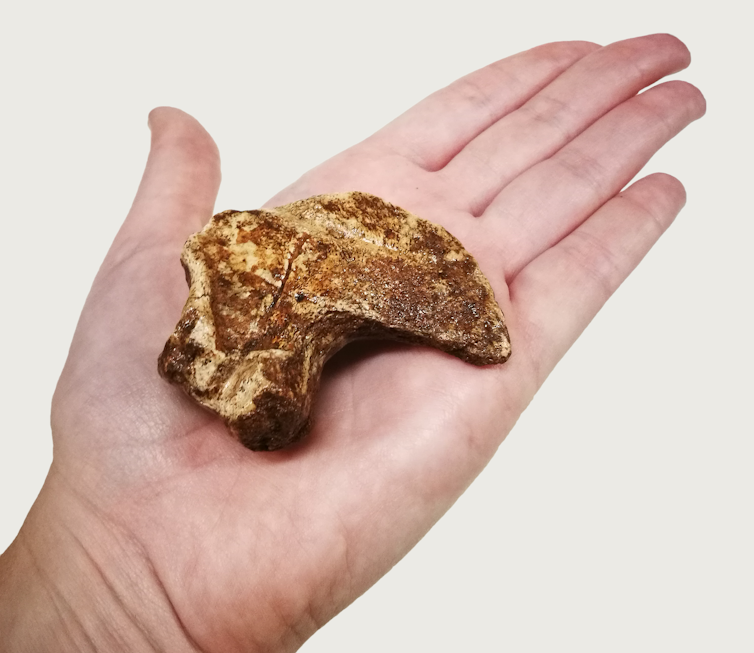
Still, for us the most interesting aspect of Palorchestes is its flattened elbow joint surfaces, which seem to indicate its elbows stayed bent at around a 100° angle.
We scanned the fossilised arm bones of Palorchestes and created computer simulations to model the full range of movements possible at its arm joint.
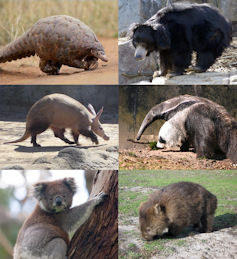
Our results indicate Palorchestes could move its elbows, but only in an off-axis motion that was tiny compared to other clawed mammals with chunky limbs such as wombats, pangolins, aardvarks and bears. Even its closest extinct megafaunal relatives had vastly more elbow function.
This suggests none of these creatures are good templates for understanding how Palorchestes moved.
By adding sliding movement as well as rotations, we used our 3D simulations to calculate the “average” motion in Palorchestes, from fully flexed to fully extended elbow poses. We found the axis of this small movement was skewed, like a “wonky” hinge.
The interactive below shows the maximum elbow motion that would have been theoretically possible for Palorchestes azael.
This skew means Palorchestes probably held its arms sprawled out from its body, allowing what little elbow mobility was possible to contribute to each stride while walking.

Arms Akimbo Make For Awkward Walking
Our findings suggest Palorchestes would have trundled along on crouched forelimbs, with its elbows sprawled out to the sides — a highly inefficient gait compared with the pillar-like limbs and tucked-in elbows of its relatives and large mammals alive today.
We think this posture was a compromise which let it use its strong arms and giant claws to access food in a specialised way, which was probably unique even back then.
While exact details remain a mystery, it could be that Palorchestes clung to tree trunks and hauled itself up onto its back legs to reach higher foliage with its long tongue.

Or it might have used its huge, bulky body to push over tree ferns to access the young nutritious fronds higher up.
Whatever it did, Palorchestes was evidently pretty successful. While its fossils are rare, they’re widely distributed right across eastern Australia.
The Specialisation Trap
The fossils of Palorchestes tell us it was a specialist, highly adapted to a forest landscape.
Large animals have large appetites to match, but Palorchestes’s inefficient walk probably limited its ability to roam widely in search of food.
This would be no problem in times of plenty. But when shifts in Australia’s climate caused sweeping environmental changes across the eastern half of the continent, large specialised megafauna such as Palorchestes were especially vulnerable.
Even small changes in the vegetation mix would have made it difficult to find enough food.
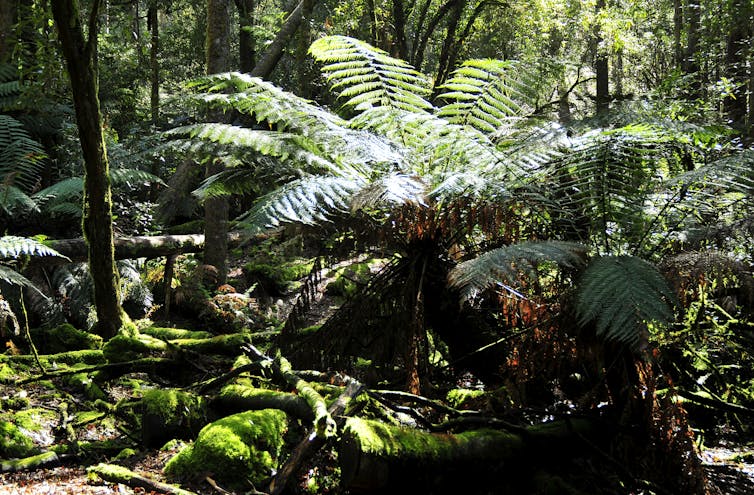
So an adaptation that can be a recipe for success in one environment can lead to a species’ demise in a changing world.
And while there’s nothing like Palorchestes alive today, many unique species now face the same fate due to drastic changes in their habitats.
Read more: Did people or climate kill off the megafauna? Actually, it was both ![]()
Hazel L. Richards, PhD candidate, Monash University; Alistair Evans, Associate Professor, Monash University; David Hocking, Postdoctoral fellow, Monash University; Justin W. Adams, Senior Lecturer, Department of Anatomy and Developmental Biology, Monash University, and Peter Bishop, Postdoctoral research fellow, Harvard Kennedy School
This article is republished from The Conversation under a Creative Commons license. Read the original article.
Millennials are not the only 'burnout generation' (just ask the rest of us)

In her new book, Can’t Even, American journalist Anne Helen Petersen writes of how Millennials have become “the burnout generation”.
[It’s] feeling that you’ve hit the wall exhaustion-wise, but then have to scale the wall and just keep going. There’s no catharsis, no lasting rest, just this background hum of exhaustion.
The book, recently released in Australia, builds on the viral essay Petersen wrote in 2019.
At its heart, the book is a critique about the nature of modern workplaces and the modern economy.
As Petersen recently told Vox,
There’s a feeling of instability that’s the baseline economic condition for many, many millennials, and it’s enhanced by these other components of our lives that make it harder to turn away from.

Petersen argues Millennials, born between the early 1980s and mid-1990s, have come of age in a world where more and more of their time is being demanded by not just work, but by life.
Technology means work follows us everywhere, at all hours, while leisure time happens (or is “performed”) on social media. Meanwhile, homes are turned into Airbnb rentals, cars become rideshare services.
What’s Age Got To Do With It?
Peterson tells real and important stories about the frustration, anxiety, and malaise of herself and her contemporaries. However, she does us all a disservice by framing this as particularly “Millennial problem”.
While Petersen does acknowledge burnout impacts everyone, she assumes Millennials are a concrete group of people whose experience of burnout is exceptional.

The idea of clear generational groups, each possessing defining characteristics seems intuitive. It makes sense a group of contemporaries who had similar experiences in their formative years, would come to have similar attitudes, values, and beliefs.
But many scholars are uncertain that the generational groups as we know them — such as Millennials, Gen X or Baby Boomers — are as real or useful as we might think.
Read more: From Boomers to Xennials: we love talking about our generations, but must recognise their limits
Empirical research to prove generational groupings has produced “highly mixed and contradictory results”. So, many academics aren’t convinced birth-year groups even exist — there are too many variables.
For example, if a 20-year-old today doesn’t follow office etiquette, is this a product of them being Generation Z? Or because this person is new to the workforce?
Read more: Millennials at work don't see themselves as millennials
More broadly, the majority of research about generations have been undertaken across Europe, North America, and Australia/Oceania. Given these three regions combined make up less than 18% of the world’s population, it becomes clear how little we know.
So, while the frustrations of Petersen and her contemporaries are real — it is important to emphasise they are something everyone is facing.
‘Feelings Of Energy Depletion’
Burnout has historically been studied in relation to workplace stress, particularly where employees are in a caring role.

It is defined by World Health Organisation as
(a) feelings of energy depletion or exhaustion; (b) increased mental distance from one’s job, or feelings of negativism or cynicism related to one’s job; and (c) reduced professional efficacy.
But medical experts are starting to see burnout as a society-wide issue, particularly as people find themselves overwhelmed and fatigued by COVID-19. Similarly, mental health groups have identified burnout as a product of long-term, or chronic, stress.
That is to say, scientists and support services are coming to understand burnout is not necessarily a product of the workplace specifically — but everything going on in someone’s life — from how much technology they use, to how many commitments they have.
Everyone Is Over It
In 2020, who of us can say they aren’t feeling burned out?
After a summer of bushfires, we had (and still have) a pandemic. For many, the boundaries between work and life have collapsed as we have needed to work, care, and relax at home — sometimes in the same room.

COVID has been accompanied by a seemingly permanent state of angst, as we all found ourselves doomscrolling for the latest updates. Many people have also lost income and job security. And more than 2 million people around the world have lost their lives.
Burnout Is About More Than The Pandemic
But it is not “just 2020”. The past several decades have seen huge changes to the way that we live, and engage with those around us.
For example, social media has had a profound effect — and not always for the better in terms of our mental health.

In the workplace, an “overtime culture” has blossomed. As of 2019, about 13% of Australia’s workforce was working more than 50 hours a week.
The rise in casual employment may have allowed for more flexibility, but it has increased insecurity — with no paid leave, and unstable work schedules.
Here it is important to note, in 2020, those aged 15-24 made up less than 40% of all casual jobs. While the casual workforce is skewed towards younger workers - the casualisation of the workforce impacts all of us.
Read more: Uber might not take over the world, but it is still normalising job insecurity
On top of all of this, we have seen rising levels of student and household debt, skyrocketing house prices, and the increasing effects of climate change.
We all have plenty of reasons to feel bombarded by life.
How Do You Solve Burnout?
So, what do we do? It goes without saying, widespread burnout due to social, economic, and political forces in the middle of a pandemic is a complex problem to solve.
At an individual level, resources do exist to help us address our mental health and support those around us.
Read more: The day is dawning on a four-day work week
However, systemic change is far more complex. Academics and world leaders have suggested reducing the work week might be an important step. Though, as noted by Peterson, it’s no longer just work demanding our time, energy, and attention.
As Peterson points out, one area that may need reimagining is how much and how often we consume information. Scholars in the 1960s were already raising concerns about the impact so much information could have on people, and in turn, society.
We as humans are social and curious creatures, but how much news, connection and information is good for us?
Comparing Generations Is A Trap
As Slate journalist Shannon Palus observes, Petersen deserves credit for identifying big problems about a culture that constantly asks for more access to every aspect of our lives.
However, framing this issue as one belonging to, or uniquely impacting Millennials is a trap. It encourages us to compare different generations to see who is the least or most burned out.
Really, our attention should be devoted to working together to reduce burnout for everyone.![]()
Steven David Hitchcock, Lecturer, University of Sydney
This article is republished from The Conversation under a Creative Commons license. Read the original article.
Wakey wakey: a history of alarm clocks and the mechanics of time

It’s the time of year when we Australians start returning to our normal rhythms. The first beats of the day are often the dreaded beeps of the alarm clock or a digital symphony from a bedside phone.
These modern electronic alarms are just the latest in a long sequence of methods used to wake us from sleep: from the watchmen on ancient city walls waiting for the dawn to more recent clocks on wheels that have to be chased to stop ringing.
The job of waking us up when our body clocks are telling us to sleep is a big ask. When did we first start using alarms, and what did they sound like? What’s changed about the sounds of time, and what hasn’t?
Birdsong
Some of the earliest words we have for time measurement show people’s particular interest in dividing up the different parts of the night.
In the pre-modern world, without electric lights and electric alarms, people paid more attention to the quality of light and the sounds around them. A rich vocabulary emerged in ancient languages for the different parts of the night. One early Latin word for the time before dawn was gallicinium, the time of the cock’s crow. Scientists have since discovered roosters really do know what time that is.

Birdsong remains an important way of experiencing waking up. In Australia, we often evoke birdsong when we think about sleep and waking — from morning caroling magpies, to the versatile currawong or the midnight call of willie wagtails. Less melodic, though equally striking, is another possible bird noise associated with early rising — “sparrow’s fart” — first attested to in the 19th century.
Read more: Birdsong has inspired humans for centuries: is it music?
Human Wake-Up Calls
The human body has developed its own repertoire of alarms.
The Islamic call to prayer, the adhan, sung by men called muezzin, is one of the most sonically striking examples, with various versions marking out differences between traditions and regions. The melismatic chant — where a single syllable is sung over several musical notes — is both a wake up call to prayer (“Prayer is better than sleep”) and a prayer in itself.
Some early-morning calls were combined with weather forecasting systems. In the 15th century the town criers of the port of Sandwich on the south coast of England would call out the wind changes in the night so seafarers would know when favourable (or unfavourable) winds sprang up. Much later, in some parts of the industrial world, professional knocker-uppers might use a pea shooter or stick to tap on windows to wake you up for your shift.
Having humans wake you up would usually mean someone has to stay up all night. But how would that person know when to cry the alarm? Sundials would obviously be useless. This is one reason technologies developed to count the hours of night — ancient and medieval water clocks with markings to show how water flow corresponded to time passing, and later (from around the 14th century) sand glasses in the familiar hourglass shape.

Mechanical Clocks
The Middle Ages saw one of our most amazing inventions — mechanical clocks, originally driven by weights. Gravity pulled suspended weights down to drive the clock mechanism. The weights were periodically wound back up for another cycle.
These clocks began as large objects in churches and town belfries. Some had elaborate automata: the extraordinary 16th-century Strasbourg clock includes a famous cockerel whose cries echo through the cathedral. Its automated rooster was a survival from an earlier clock made in the 14th century, and included as part of the new renaissance clock.

Some large clocks played music on bells before striking the hours. This year is the 700th anniversary of what may be the first such musical clock, installed in a monastery near Rouen in 1321. It played a hymn, Conditor alme siderum (Dear Creator of the Stars), for the season of Advent that starts the Christian year.
Such chimes are our first recorded mechanical music, and a precursor to today’s musical alarms. The technology was probably developed by tech-geek monks as a way of dealing with waking up to sing their prayers in the night — even better if that wake-up call, like the adhan, was a pious prayer itself.
Read more: Acedia: the lost name for the emotion we're all feeling right now
The Modern Alarm Clock
The earliest versions of the clocks we know today were made for large communities, public spaces or courtly elites.

Gradually though, and certainly by the mid to late 15th century, you could find heavy iron wall clocks in private houses (made in places still famous for clockmaking, such as Switzerland). These often had pins that you could place around the clock face to set the bell ringing at a particular time. These house alarm clocks could wake the owner to work and pray.
It was during this period, too, that compact spring mechanisms made smaller and smaller personal watches possible, carried or worn on the body from the 16th century.
The personalisation of time accelerated in the 19th century and gave rise to some wild modern alarm clocks. Among the more striking inventions of the French magician Jean-Eugène Robert-Houdin was a clock that lit a candle after the alarm sounded.
Read more: Morning haze: why it's time to stop hitting the snooze button
Though nothing has reached the sophistication of the breakfast-making Rube-Goldberg-style alarm clocks seen on The Goodies, automaton clock alarms have promised freshly made coffee and toast or even just their aroma. Here the familiar sounds of the kitchen, with their enticing morning smells, soften the rude awakening from sleep.
Today’s alarms, with all their invention, come as a gift (or depending on how much you enjoy waking up, a curse) from the Middle Ages to us today.![]()

Matthew S. Champion, Senior Research Fellow in Medieval Studies, Australian Catholic University
This article is republished from The Conversation under a Creative Commons license. Read the original article.
Film review: Wild Things packs passionate climate activism into an overly polite documentary

The content of some films is so close to the heart that it’s difficult to critically evaluate them. If you’re an atheist, The Passion of the Christ is not for you. By the same token, if you’re a denier of anthropogenic global warming, then you’ll hate Wild Things, the latest film from Australian producer-director Sally Ingleton.
A passionate call to action against global warming, Wild Things is documentary at its slickest, even if it is oddly-named (sharing the title with the 1998 risque romp Wild Things).
It seamlessly combines archival footage, camera phone footage, stunningly panoramic aerial photography and beautiful-in-forest images with the whole thing anchored around a group of very likeable environmental activists.
To Every Season, Turn
In keeping with the subtitle — A Year on the Frontline of Environmental Activism — Wild Things follows a group of activists (it’s not clear why they are called “wild things” or by whom) – with each section of the film following a season.
We move from the anti-Adani campaign in Central Queensland led by Andy Paine at Camp Binbee, to Lisa Searle and the campaign to save old-growth forests in Tasmania, to high school students Milou Albrecht and Harriet O’Shea Carre from Castlemaine in regional Victoria as they found their own climate change movement.

The groups often face serious peril — we see a semi-trailer pushing against protesters outside an Adani contractor site — yet continue their passionate fight for ecological justice.
In many respects, this is an optimistic film. We can feel the enthusiasm of Albrecht, and O’Shea Carre as their campaign spreads from 20 to thousands of students. We even travel to New York City with the latter as she watches, starstruck, as her idol Greta Thunberg addresses a rally.
In other ways, the film is deeply sad. We are forced to witness the brutal destruction of Tasmanian forests.
Read more: Friday essay: why we need children's life stories like I Am Greta
Across Time And Place
The old cliche of the dole-bludging treehugger is quickly dispensed with. We follow an organised group of people as they brush up against the systems that began and perpetuate anthropogenic global warming. There isn’t much of a focus on their powerful antagonists, but, one senses, they probably don’t need more opportunities in the spotlight.
We also see the activists’ canny use of social media and new technologies to generate support. As the film points out, these are radically different times from those of the Franklin River Dam protest, when film had to be flown in and out every day.
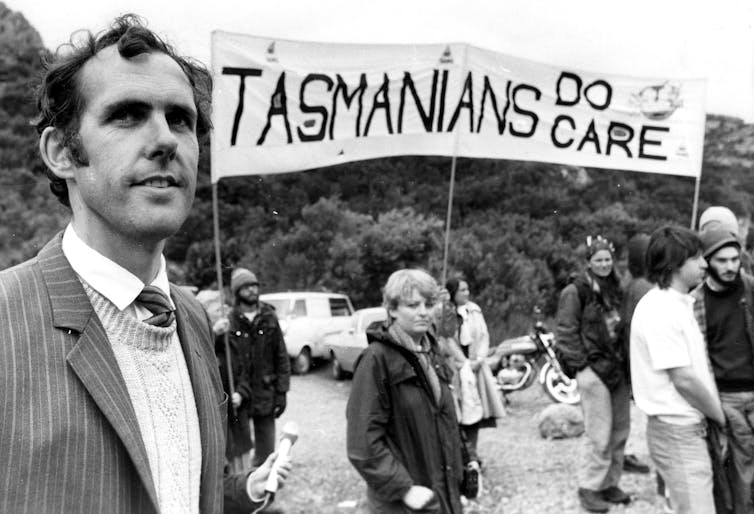
Specific campaigns are put in the broader context. The film’s style — its balance between types of footage, and across geographical and temporal locations — seems to embody an ecological rationale. Every part (past or present, here or there) is connected to every other part.
And so notable past Australian environmental campaigns are interspersed with coverage of the current year. The Green Bans in Sydney’s Rocks in the 1970s, Bob Brown and the Franklin River Dam protests in the 1970s and 1980s, and the anti-Jabiluka mine protest of 1998 all make an appearance. Some of this involves contemporary interviews with major players, but much of it is meticulously put together from archival footage.
This temporal cross section seems as significant as the geo-spatial one, and this appears to be a key point the film would like to make. Global warming and ecology are about time — like all death, about temporal limitation.
The continuity of these struggles past and present is of prime significance — the victories as well as the defeats.
Read more: Ignoring young people's climate change fears is a recipe for anxiety
Passive Protest
Wild Things may have been conceptually stronger — and more critically coherent — if this point had been made in a more forceful and direct fashion.
Perhaps this is part of its vision — things aren’t neat in this space. Or maybe it’s symptomatic of a more significant criticism: the whole thing seems a little too polite.

Wild Things is a document of people struggling to save the planet — and this is as brutal and existentially charged a battle as you can get, lebensraum (the German concept of “living space” for humans) for the population of the entire globe.
Yet interviewees repeatedly emphasise they are “non-violent” as though constantly apologising, in advance, to some imagined criticism.
This disclaimer appears frequently towards the beginning of the film, as though thereby allowing it entry into polite discourse. At times the film seems similarly gentle, genteel — even middlebrow — in its approach to global warming.
It is most impressive as a piece of documentary cinema. Its production value is exceptional, and the balance, in terms of style of footage, is excellent. Fly-on-the-wall footage unfolds amid carefully placed interviews and video diaries. The 90-minutes duration passes in a flash.
The score is a little uninspired but also doesn’t distract from the content of the film. A documentary of this scale is not going to be able to afford composer John Williams — but Missy Higgins sings the closing number, The Difference.
Wild Things is definitely not a non-partisan film — but why should it be? It’s on the side of the population of the globe!
Still, a more detailed and engaged analysis of the relationship between past and present would have enriched its ultimate call to action. It is good — it’s emotionally compelling and enjoyable — but one can’t help feeling a more intellectually robust and less sentimental approach may have made it great.
Read more: How the youth climate movement is influencing the green recovery from COVID-19
Wild Things is in cinemas from today.![]()
Ari Mattes, Lecturer in Communications and Media, University of Notre Dame Australia
This article is republished from The Conversation under a Creative Commons license. Read the original article.
Taking care of business: the private sector is waking up to nature's value

For many businesses, climate change is an existential threat. Extreme weather can disrupt operations and supply chains, spelling disaster for both small vendors and global corporations. It also leaves investment firms dangerously exposed.
Businesses increasingly recognise climate change as a significant financial risk. Awareness of nature-related financial risks, such as biodiversity loss, is still emerging.
My work examines the growth of private sector investment in biodiversity and natural capital. I believe now is a good time to consider questions such as: what are businesses doing, and not doing, about climate change and environmental destruction? And what role should government play?
Research clearly shows humanity is severely damaging Earth’s ability to support life. But there is hope, including a change in government in the United States, which has brought new momentum to tackling the world’s environmental problems.
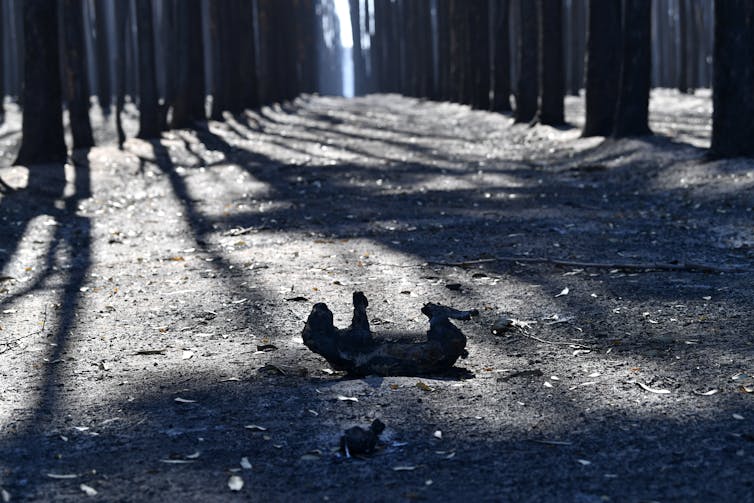
Poisoning The Well
An expert report released last week warned Australia must cut emissions by 50% or more in the next decade if it’s to meet the Paris Agreement goals. Meeting this challenge will require everyone to do their bit.
Climate change is a major threat to Australia’s financial security, and businesses must be among those leading on emissions reduction. Unfortunately, that’s often not the case.
The finance sector, for example, contributes substantially to climate change and biodiversity loss. It does this by providing loans, insurance or investment for business activities that produce greenhouse gas emissions or otherwise harm nature.
In fact, a report last year found Australia’s big four banks loaned A$7 billion to 33 fossil fuel projects in the three years to 2019.

A Pushback For Nature
Promisingly, there’s a growing push from some businesses, including in the finance sector, to protect the climate and nature.
Late last year, Australian banks and insurers published the nation’s first comprehensive climate change reporting framework. And the recently launched Climate League 2030 initiative, representing 17 of Australia’s institutional investors with A$890 billion in combined assets, aims to act on deeper emissions reductions.
Read more: Worried about Earth's future? Well, the outlook is worse than even scientists can grasp
Some companies are starting to put serious money on the table. In August last year, global financial services giant HSBC and climate change advisory firm Pollination announced a joint asset management venture focused on “natural capital”. The venture aims to raise up to A$1 billion for its first fund.
Globally too, investors are starting to wake up to the cost of nature loss. Last month, investors representing US$2.4 trillion (A$3.14 trillion) in assets asked HSBC to set emissions reduction targets in line with the Paris Agreement. And in September last year, investor groups worth over $US103 trillion (A$135 trillion) issued a global call for companies to accurately disclose climate risks in financial reporting.

Climate change is not the only threat to global financial security. Nature loss – the destruction of plants, animals and ecosystems – poses another existential threat. Last year, the World Economic Forum reported more than half of the global economy relies on goods and services nature provides such as pollination, water and disease control.
Efforts by the finance sector to address the risks associated with biodiversity loss are in their infancy, but will benefit from work already done on understanding climate risk
Of course, acknowledging and disclosing climate- and nature-related financial risks is just one step. Substantial action is also needed.
Businesses can merely “greenwash” their image – presenting to the public as environmentally responsible while acting otherwise. For example, a report showed in 2019, many major global banks that pledged action on climate change and biodiversity loss were also investing in activities harmful to biodiversity.
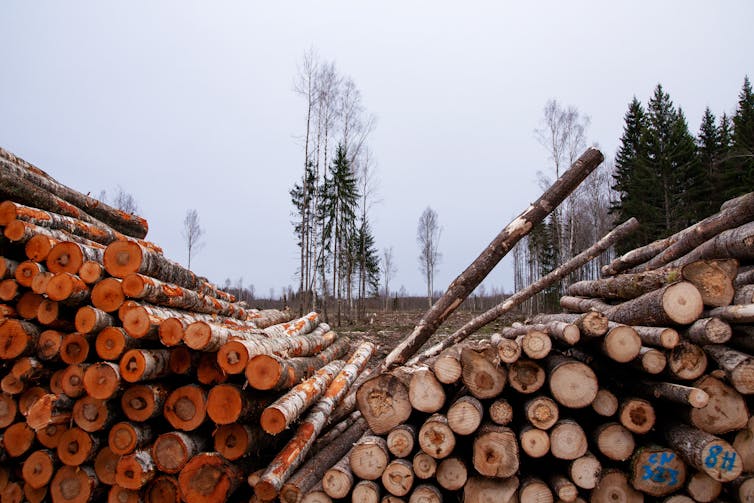
Getting It Right
In the financial sector and beyond, there are risks to consider as the private sector takes a larger role in environmental action.
Investors will increasingly seek to direct capital to projects that help to reduce their exposure to climate- and nature-related risks, such ecosystem restoration and sustainable agriculture.
Many of these projects can help to restore biodiversity, sequester carbon and deliver benefits for local communities. But it’s crucial to remember that private sector investment is motivated, at least in part, by the expectation of a positive financial return.
Projects that are highly risky or slow to mature, such as restoring highly threatened species or ecosystems, might struggle to attract finance. For example, the federal government’s Threatened Species prospectus reportedly attracted little private sector interest.
That means governments and philanthropic donors still have a crucial role in the funding of research and pilot projects.
Read more: A major report excoriated Australia's environment laws. Sussan Ley's response is confused and risky
Governments must also better align policies to improve business and investor confidence. It is nonsensical that various Australian governments send competing signals about whether, say, forests should be cleared or restored. And at the federal level, biodiversity loss and climate change come under separate portfolios, despite the issues being inextricably linked.
Private-sector investment could deliver huge benefits for the environment, but these outcomes must be real and clearly demonstrated. Investors want the benefits measured and reported, but good data is often lacking.
Too-simple metrics, such as the area of land protected, don’t tell the whole story. They may not reflect harm to local and Indigenous communities, or whether the land is well managed.
Finally, as the private sector becomes more aware of nature and climate-related risks, a range of approaches to addressing this will proliferate. But efforts must be harmonised to minimise confusion and complexity in the marketplace. Governments must provide leadership to make this a smooth process.
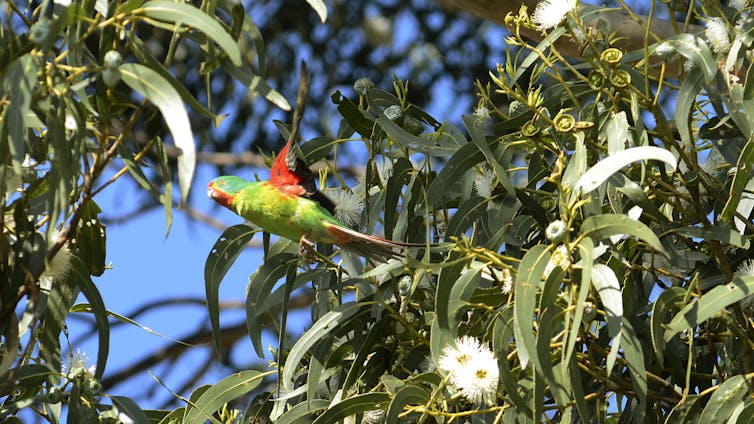
The Power To Change
Last week, a major report was released highlighting grave failures in Australia’s environmental laws. The government’s response suggested it is not taking the threat seriously.
Businesses and governments hold disproportionate power that can be used to either delay or accelerate transformative change.
And although many businesses wield undue influence on government decisions, it doesn’t have to be this way.
By working together and seizing the many opportunities that present, business and government can help arrest climate change and nature loss, and contribute to a safer, more liveable planet for all.
Read more: You can't talk about disaster risk reduction without talking about inequality ![]()
Megan C Evans, Lecturer and ARC DECRA Fellow, UNSW
This article is republished from The Conversation under a Creative Commons license. Read the original article.
First Day Of Kindy + World Radio Day 2021
We hope all of you who started your first day of school this week had a great time.
The film below was made in 1951, before television started in Australia (black and white in 1956) and when most homes listened to radio to get their news of to be entertained by music and 'radio plays'.
Although this is 70 years old, we thought you may like to look at how the landscapes have changed and think about how we communicate today - at school, and outside of school, and ask yourself - is radio still important today?
World Radio Day happens next Saturday, February 13th. It is an international day celebrated on February 13th each year. The Day was decided by UNESCO on November 3rd 2011 during its 36th conference.
Each year there is a different 'theme' chosen. In honour of the first World Radio Day in 2012, Lifeline Energy, FrontlineSMS, SOAS Radio and Empowerhouse hosted a seminar in London. A variety of practitioners, academics and tools providers joined at the School of Oriental and African Studies to explore ways in which radio reaches even the most remote and vulnerable communities.
In 2015 the 'theme' was Youth and Radio, with the goal of increasing the participation of young people in radio. In 2016 it was Radio in Times of Emergency and Disaster, while in 2017 it was "Radio is You", with the goal of celebrating how audiences interact with radio.
World Radio Day 2021 (WRD 2021) celebrates radio as part of humanity’s history by following the various developments in our society and adapting its services. As the world changes, so does radio. Thus, during the Covid-19 pandemic, radio made it possible, for example, to ensure continuity of learning, to fight against misinformation, and to promote barrier gestures.
"New World, New Radio" is, therefore, an ode to the resilience of radio. It is a tribute to its capacity for perpetual adaptation at the rate of societal transformations and listeners’ new needs. Accessible anywhere and anytime, radio reaches a broad audience. It presents itself as an arena where all voices can be expressed, represented, and heard hence why radio is still the most consumed medium worldwide today.
On the occasion of World Radio Day 2021 (WRD 2021), UNESCO calls on radio stations to celebrate this event’s 10th anniversary and the more than 110 years of radio through three sub-themes.
- Evolution: The world changes, radio evolves – radio is resilient and sustainable;
- Innovation: The world changes, radio adapts and innovates- radio adapts to new technologies and remains the go-to medium of mobility, accessible everywhere and to everyone;
- Connection: The world changes, radio connects - radio services our society during natural disasters, socio-economic crises, epidemics, etc.
Of course you can just do as we did when your age and turn the radio up and DANCE!
Hope you all have a wonderful second week of Term 1, 2021.
Picnic Day
By Dorothea Mackellar.
For weeks we thirsted for its coming
Childhood's long weeks that, stretch like years ,
Until at last it dawned in glory,
The crowded day of hopes and fears.
Full half the sky teas curtained crimson:
Sleepy, nurse helped us dress: a thrill
We walked through, unfamiliar shadows
Beach wards ; the sun just topped the hill
Old Sam was wailing at the jetty,
Gnarled as a vine-stock, cheery-lipped.
'Fine day mum! 'Mornin', mate'. No hurry —
Go easy till the tucker's shipped!''
Wriggling, we watched those lagging grown-ups
Slow, slow as treacle, stow away
Our picnic baskets in the dinghy —
We wanted to begin the Day.
Small gilded waves came dancing towards us
And slapped the keel, turned beryl-clear
And, made a lovely sunshot shadow;
The rowlocks creaked : our Day was here.
Across a sparkling stretch of harbour,
Diamond-fair in morning light,
Grave as a child himself, Sam rowed us,
Until our white beach came in sight
Round Bradley' s Head. We other children,
Joy rapt, stirred neither foot nor hand;
But we leapt yelling from the dinghy
Before her nose had ploughed the sand,
And up the beach, the dry sand squinching
Beneath our feet, to choose a place
To cast our shoes and stockings from us,
We ran a headlong, desperate race.
Then down to meet the dancing water,
And through it watch our white feet, clad
In shifting golden scales of sunlight,
As bright as ever sea-beast had.
Each rosy wilderness of rockpool
We pored upon, its life to see.
While on the velvet-surfaced ironstone
Our bare feet clung voluptuously.
Pink shells and purple, crabs and starfish.
And lovely nameless mysteries
We gathered, dropping them to tickle
The fruit-like sea-anemones.
The royal day went by like, music,
We never paused, to hear it pass.
Not even as we ate ambrosia.
Sprawled idle on the wiry grass.
Then home at dusk, our fingers trailing
In dark leaves lipped with phosphor fire,
Each sleepy salty head- still humming
With tunes of satisfied desire.
Ah, it was over, over, over,
The longed-for day of our delight:
But, soaked with scents and sounds and colours.
We all possessed the sea that night.
Before our closed eyes flamed the beaches
And jewelled rock-pools all night long
And through our dreams the waves came chanting
Their everlasting marching song.
Picnic Day (1924, January 9). Sydney Mail (NSW : 1912 - 1938), p. 36. Retrieved from http://nla.gov.au/nla.news-article166152694
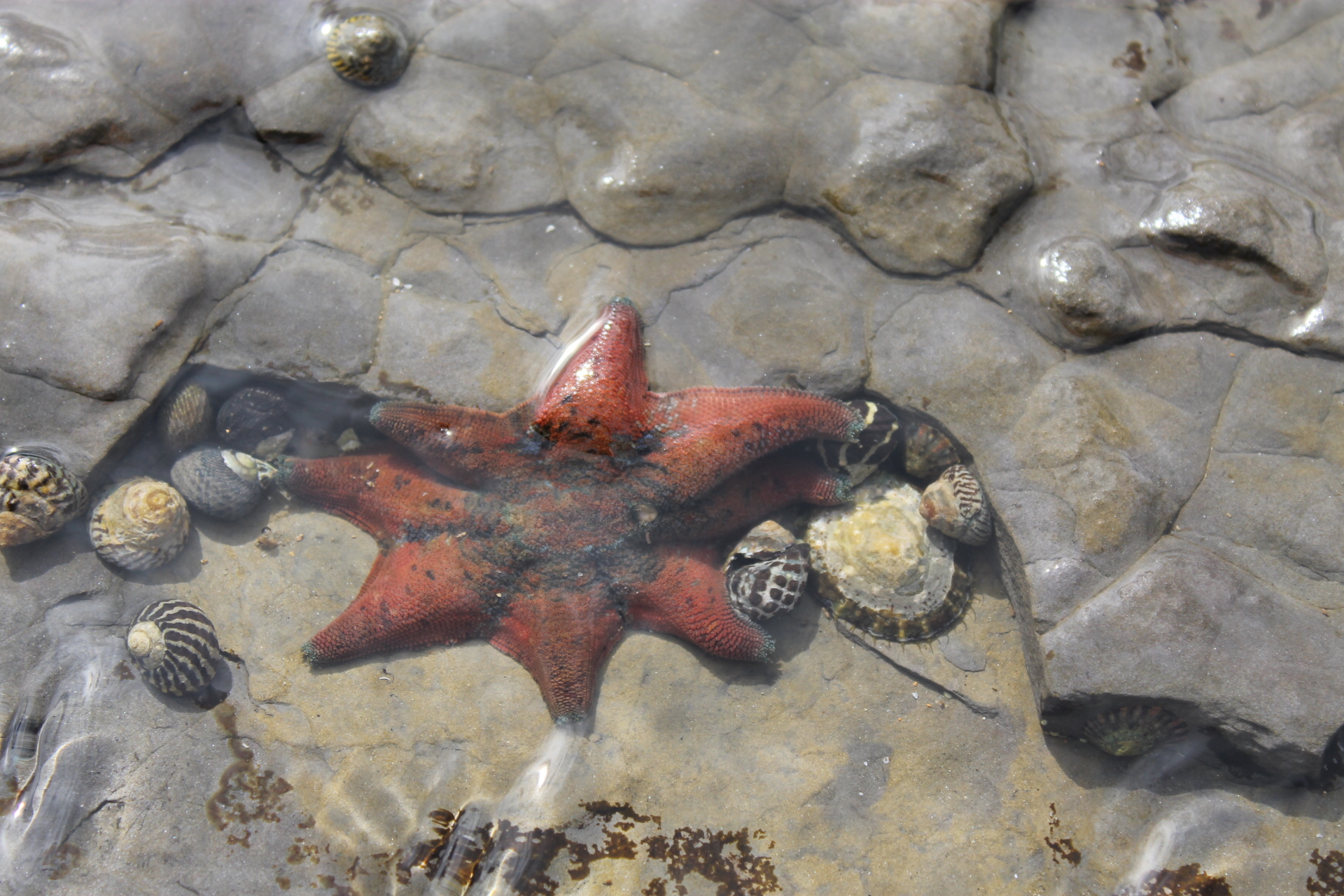
How To Plant A Tree
Published by the Royal Botanic Garden Sydney, January 2021
Learn how to plant a tree with our experienced community greening coordinator Peter Dawe.
Curious Kids: Could Someone Become A Superhero In Real Life?
Could someone become a superhero in real life? – Emma, aged six, Tonbridge, UK
Answered by Sarah Hainsworth, Pro-Vice-Chancellor and Executive Dean and Professor of Materials and Forensic Engineering, Aston University and Michael Fitzpatrick, Pro-Vice-Chancellor and Lloyd's Register Foundation Chair in Structural Integrity and Systems Performance, Coventry University - part of the Curious Kids series by The Conversation
Do you know the difference between these two groups of superheroes?
- Dr Strange, Scarlet Witch, Superman.
- Black Panther, Black Widow, Iron Man.
The answer is that the superheroes in the first group all have personal superpowers that means they can do things that no ordinary human can: Dr Strange can teleport from one place to another, for example, and Scarlet Witch can move things with the power of her mind.
On the other hand, the people in the second group are all ordinary humans who use their skills to achieve what most of us would find impossible. In many cases, they also use advanced or secret technologies.
These technologies are made up, and in the main they were invented by comic writers like Stan Lee over 50 years ago. Now we are in the 21st century, the technologies that exist today are catching up with the inventions from the comics of the 1960s – so maybe someone could become a superhero like Black Panther or Iron Man in real life in the future.
Let’s start with Iron Man. He is able to fly using a personal jet pack. The real-life problem is being able to carry enough fuel to go far enough for it to be worthwhile.
In October 2019, a new speed record for flying with a jet pack was set by Richard Browning in the UK. Browning was wearing a suit powered by six gas turbine engines. Like Iron Man, he used his hands to provide the steering, with two small motors on each hand, and then two larger turbines on the back to get him off the ground and keep him in the air.
He reached a speed of 85mph (135km/h), flying over the sea in Brighton, UK, (guaranteeing a soft landing if things went wrong). Browning also tested out using the jet pack to rescue people stranded on a mountain. In a practice rescue scenario in the Lake District, Browning was able to reach a casualty in 90 seconds. A normal rescue team would expect to take 25 minutes. Tony Stark would approve.
Superheroes often rely on fictional materials. Black Panther’s suit is made with the element “vibranium”, which absorbs energy and can release it later when desired. In reality, all the elements – the atoms that make up all the materials in the world around us – have been discovered: there aren’t any “super-elements” like vibranium waiting to be found. Scientists have been making new “heavy” elements in particle accelerators by smashing atoms together, but they are unstable and last seconds or less before splitting apart.
But that hasn’t stopped engineers from making innovations in materials using the elements that we already have. Paralympians use “blade” prosthetic legs to ski, run and jump. These blades are made using the element carbon, which is found throughout nature and is amazingly versatile. In different forms it makes diamonds – the hardest substance on Earth – and graphite, which can be used in oils as a lubricant.
In the blades, the carbon is in the form of fibres, woven like cloth and then sealed with a resin that acts as a glue to bind them together. The blades store energy and then return the energy to the athlete. This allows the athletes to run at high speeds, to the extent that Paralympic runners are now faster than the Olympians of the last century.
Other superheroes use technologies to help them manage their powers. In the Incredibles, Baby Jack-Jack can light up on fire, so he needs a suit made of material that won’t burn. We have developed materials like this in real life.
At the Bahrain Grand Prix in November 2020, driver Romain Grosjean crashed into a barrier at 140 mph. His car broke into two pieces and caught fire so fiercely that it appeared to have exploded. Grosjean not only survived the crash but quite literally walked away.
This was because of the energy absorbing properties of the crash protection systems in his car, and because of his racing suit. The suit is made of a fireproof fibre called Nomex. It is engineered so when it is exposed to flames it does not melt, combust, or conduct heat through to the wearer.
So year-on-year, the technologies that set apart the superheroes of the 1960s are becoming the tools of real heroes today. Teleportation, telekinesis, and telepathy remain in the realms of fantasy for now, but there are researchers working on linking our brains directly with computers, so who knows what the future holds?

Curious Kids: why are our top eyelashes longer than our bottom eyelashes?

Why are our top eyelashes longer than our bottom eyelashes? Lilia, aged 7
Thanks for this great question, Lilia.
The upper eyelid is larger, longer and has deeper roots so it can support more luscious lashes.
All mammals have this feature, but why have the eyes developed this way?
The most significant reason is to protect our eyeballs. But having longer top eyelashes can also help us express our feelings and communicate with others.
They Protect You
We have between 90 and 160 eyelashes in each upper lid, each of which grow between 8mm and 12mm long. In each lower lid, we have around 75 lashes which grow 6–9mm long.
Together, your long top and shorter bottom lashes provide a curtain of protection that covers the whole eye socket. This stops dust, insects or sweat getting into your eye and hurting it.
Without eyelashes, your eye would also dry out much quicker, and would be more likely to catch nasty germs. This is why people without eyelashes have to blink much more often.
Read more: Curious Kids: will I go blind if I shut my eyes and face the Sun?

There is actually an “ideal length” for upper eyelashes.
Using eyelash lengths from humans, as well as across a range of animal species, this is one-third the width of the eye. Any shorter and wind gets through too easily. Any longer and the wind starts to become caught under the lashes, with both scenarios causing the eyes to dry out more.
Read more: Curious Kids: Why do tears come out of our eyes when we cry?
Eyelashes Protect Animals Too
Humans are not the only animals that have eyelashes — all mammals have them, including cats, dogs, elephants, and mice. But they differ in length and density depending on where the animal lives. In most cases, other animals also have much longer lashes on the upper lid.
For animals that live in dusty areas, their eyelashes stop them getting specks of dust in their eyes. This is why camels, kangaroos, elephants and giraffes have several rows of long eyelashes, not just one row.
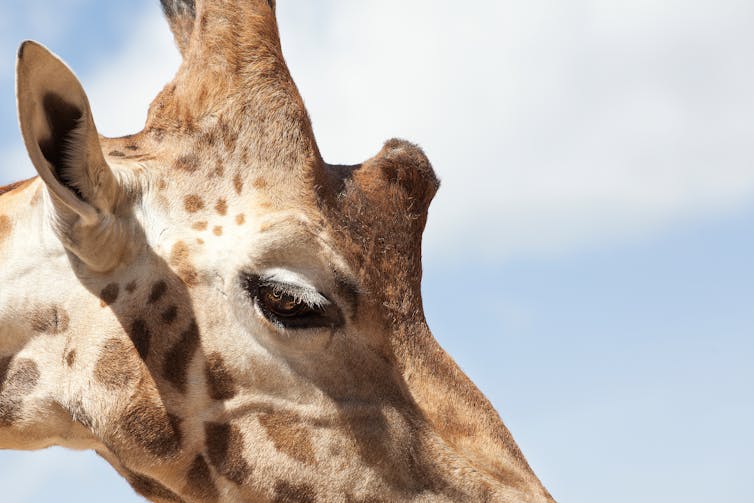
In rodents, such as rats, eyelashes are positioned around the eye and act as sensors. That way, rats can protect their eyes by blinking whenever they sense an unknown object near their eyes.
But it’s not just mammals. Birds have also developed eyelash-like feathers around their upper eyelids.
These feathers protect birds’ eyes from sunlight by casting a shadow on their eye. Compared to mammals, these eyelash-like feathers are long (up to 2cm), thick, and widely spaced out.
Other Ways Eyelashes Are Useful
Our eyelashes are also important for when we meet and talk to other people.
If you are feeling tired, surprised or concerned, your eyelashes can help someone else tell how you are feeling. Also, fluttering your eyelashes at someone might be a way to indicate you really like them. The extra length of the top eyelashes helps to emphasise this.
Read more: Curious Kids: how do eyes grow?
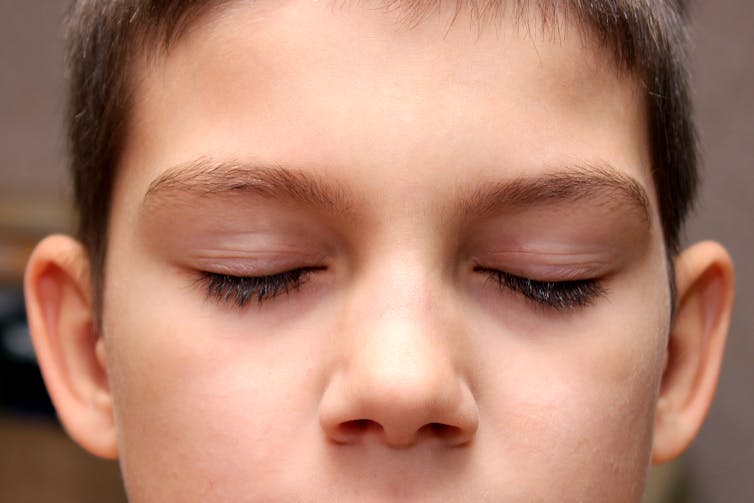
Lash Facts
Unlike most other hairs in our body, eyelashes don’t have the tiny muscles that make the hairs stand on end, giving us goosebumps
eyelashes are usually the darkest-coloured hair in our body, and they never go grey!
the early Egyptians used makeup on their eyelashes, just like many people do today. They lived more than 5,000 years ago
eyelashes vary a lot between people. Different people can have big differences in the number, thickness, curliness, shape or length of their eyelashes
lashes curve outwards from the eye so the top and bottom hairs don’t get tangled up when we blink
if we pull out our eyelashes it takes about eight weeks for them to grow back. So it’s probably best not to!
Read more: Curious Kids: why do our toes and fingers get wrinkly in the bath?
Hello, curious kids! Have you got a question you’d like an expert to answer? Ask an adult to send your question to curiouskids@theconversation.edu.au![]()
Christian Moro, Associate Professor of Science & Medicine, Bond University and Zane Stromberga, PhD candidate, Bond University
This article is republished from The Conversation under a Creative Commons license. Read the original article.
NSW Seniors Festival 2021
NSW Seniors Festival will run 13 - 24 April 2021
This year’s theme is ‘In our nature’.
The Comedy Show at Sydney Town Hall
The annual Comedy Show at Sydney Town Hall will be held on Tuesday 13 April 2021.
Tickets are free but limited. They will go on sale in early 2021.
Subscribe to our newsletter to be notified when they go on sale.
Premier’s Gala Concerts
The star-studded Premier’s Gala Concerts are one of the highlight events of the NSW Seniors Festival. In 2021 the concerts will be held on Wednesday 21 April and Thursday 22 April at Aware Super Theatre, ICC Sydney in Darling Harbour.
The concerts are free but you will need a ticket. Be sure to sign up to our newsletter or follow us on Facebook to be notified when tickets go on sale.
Subscribe to our e-newsletter for future updates.
NSW Seniors Expo
The NSW Seniors Festival Expo is an annual free and fun event. Featuring over 60 exhibitors, live stage entertainment and plenty of games, giveaways and workshops, the Expo has all the latest information on travel, lifestyle, health, services and more.
When: Wednesday 21 April 2021, 9am – 6pm and Thursday 22 April 2021, 9am – 6pm
Where: Hall 4, Exhibition Centre, International Convention Centre, Sydney
'Attitude Of Gratitude' Keeps Older People In Japan Feeling Hopeful As They Age
January 2021
Older people in Japan have an "attitude of gratitude" which keeps them feeling hopeful despite the challenges of aging, a new study says.
Feeling thankful and grateful for the care and support they have had during their life helps pensioners in the country to be more optimistic, even when they experienced difficulties and were anxious about getting older, an expert found.
Dr Iza Kavedzija, from the University of Exeter, observed people in their 80s and 90s in the course of long-term ethnographic fieldwork in a merchant neighbourhood in the city of Osaka. Her research is published in the journal Anthropology and Aging.
Dr Kavedzija found many members of the older community cultivated a "quiet hope," even though they had concerns for the future, such as getting dementia like their parents or becoming a burden to their children. They said they believed things would work out "somehow" (nantonaku). They accepted the uncertainty ahead, but remained actively engaged in their wider community. This gave them a sense of security, and offered them some confidence for the future.
Dr Kavedzija said: "As people move through life, through their later years, many experience a sense of loss. But this time for them also offers opportunities to reflect more on life, with a heightened realisation of their interconnections with others. If one habitually invokes the involvement of others and their role in one's life, one is reminded how much other people have helped them, in countless small and more substantive ways. The same events seem different when one focuses on how others have helped."
"An attitude of gratitude was embedded in older peoples' recollections of the past, but also allowed them to think about the present in a hopeful way. A world in which one has received much good will from others is a different place than one in which one has experienced loss, even if the facts of life are the same."
"Gratitude in Japan can be seen to a large extent as a recognition of how much one relies on others as one moves through life. Gratitude highlights feelings of interdependence in the social world."
Many people said they wouldn't be the person they were without others who played a significant part in their life. A phrase they liked to use was arigatai, "I am grateful," and sometimes kansha, "gratitude." This gratitude might exist for having been able to lead a full life, for having had a good husband who supported the family, for having understanding in-laws, or simply for an opportunity to work.
Dr Kavedzija said: "While people in Japan might hesitate to say they are happy, gratitude is mentioned frequently. Through appreciation, dependence on others is not seen as simply a burden or a potential source of embarrassment, but also as moving and deeply meaningful. Meaningful relationships and encounters with others comprise a valuable foundation for what Japanese people call ikigai, or that which makes life worth living."
Iza Kavedzija. An Attitude of Gratitude: Older Japanese in the Hopeful Present. Anthropology & Aging, 2020; 41 (2): 59 DOI: 10.5195/aa.2020.244
New Discovery For How The Brain 'Tangles' In Alzheimer's Disease
February 3, 2021
University of Queensland researchers have discovered a new 'seeding' process in brain cells that could be a cause of dementia and Alzheimer's disease.
UQ's Queensland Brain Institute dementia researcher Professor Jürgen Götz said the study revealed that tangled neurons, a hallmark sign of dementia, form in part by a cellular process that has gone astray and allows a toxic protein, tau, to leak into healthy brain cells.
"These leaks create a damaging seeding process that causes tau tangles and ultimately lead to memory loss and other impairments," Professor Götz said.
Professor Götz said until now researchers did not understand how tau seeds were able to escape after their uptake into healthy cells.
"In people with Alzheimer's disease, it seems the tiny sacs transporting messages within or outside the cells, called exosomes, trigger a reaction which punches holes in the wall of their own cell membrane and allows the toxic seeds to escape," he said.
"As more tau builds up in the brain, it eventually forms tangles, and together with abnormally configured proteins known as amyloid plaque, they form the key features of these neurological diseases."
Queensland Brain Institute researcher Dr Juan Polanco said the findings would help scientists piece together how non-inherited forms of Alzheimer's disease and other dementias occur.
"The more we understand the underlying mechanisms, the easier it will be to interfere with the process and to slow down or even halt the disease," Dr Polanco said.
"Along with Alzheimer's, this cellular process might also play a leading role in other cognitive diseases, from frontal lobe dementia to rare neurological disorders with toxic tau.
"Even in cancer research, there is emerging evidence showing these exosomes can load unique messages that reflect the condition of tumours and enables them to replicate and spread cancer more quickly through the body.
"Improving our understanding of how Alzheimer's and other diseases spread through exosomes will allow us to create new ways to treat and intervene in these cellular processes in the future."
Professor Götz directs research at QBI's Clem Jones Centre for Ageing Dementia Research. A team in his research group, led by Dr Polanco, is looking at the role of exosomes and cell dysfunction as a risk factor in neurodegenerative diseases.
Juan Carlos Polanco, Gabriel Rhys Hand, Adam Briner, Chuanzhou Li, Jürgen Götz. Exosomes induce endolysosomal permeabilization as a gateway by which exosomal tau seeds escape into the cytosol. Acta Neuropathologica, 2021; 141 (2): 235 DOI: 10.1007/s00401-020-02254-3
Research Finds COVID Plasma Donation Is Fuelled By Kindness
February 3, 2021
Researchers have given new insights into why people would choose to donate Covid-19 plasma after recovering from the virus, which will be used to support the recruitment of convalescent plasma donors to help treat current Covid-19 patients and support ongoing trials.
Researchers from the University of Nottingham's School of Psychology, in collaboration with Australian Red Cross Lifeblood and the University of Queensland Australia have been the first in the world to examine the motivations and barriers to convalescent plasma donation in the UK. The findings published in Transfusion Medicine, showed that most people would choose to donate as they want to show their gratitude by giving something back after recovering.
Convalescent plasma is a treatment being trialled for Covid-19 and involves blood plasma from recovered Covid-19 patients being transfused into patients who are currently in hospital with the virus. This provides 'passive' immunity as the antibodies against Covid-19 are transferred from the recovered patient to the current patient to support their immune system to fight the virus.
Professor Eamonn Ferguson from the University of Nottingham's School of Psychology was one of the lead authors on the study, he said: "The use of convalescent plasma as a treatment relies on the generosity and 'altruism' of those who have recently recovered from the virus to help those currently ill. To enhance the recruitment of convalescent plasma donors -- much as blood donors in general -- we need to understand what would motivate, or even defer, those who are eligible to be convalescent plasma donors to donate."
The study involved 419 UK residents who indicated they had been infected with Covid-19 and were eligible to donate convalescent plasma. They were asked about their awareness of convalescent plasma, motivations, and barriers to donating.
The researchers identified six key motivations -- Altruism from adversity, post-traumatic growth, moral and civic duty to help research, patriotism and control, reluctant altruism, and signalling reluctant altruism. They found the main motivation to donate from these was altruism from adversity -- people being grateful to have survived with a sense of pay-it-back and pay-it-forwards reciprocity, and moral and civic duty- the morally right thing to do to help family, friends and support research.
Barriers to donating were also explored -- not well enough, logistics, generic donation fears, lack of trust in institutions, fear of re-infection, infection and process risk to self and others and worry that others will know of COVID-19 infection. Of these, generic fears were the biggest barrier with a fear of needles being a particular deterrent.
Professor Ferguson continues: "These results highlight the extreme kindness, generosity, and cooperative spirit of human nature. Even under the adverse condition of a global pandemic, people are willing to help strangers and those who are in need which is borne out of adversity but also a moral sense of what is right. This is a real good news study about the human condition and how we are all there for each other. Indeed, little put people off donating convalescent plasma other than a general fear of needles.
The results also suggest several ways that transfusion services to develop recruitment campaigns to attract more convalescent plasma donors. These could focus on simple gratitude interventions, ideas of pay-it-back reciprocity, and moral imperatives.
We feel these new and novel findings have the potential to help in the fight against COVID-19 by providing evidence about ways to support the recruitment of convalescent plasma donors that are urgently needed to support ongoing research trials and treatment of patients."
Dr. Rachel Thorpe from Australian Red Cross Lifeblood said: "It's incredibly useful for transfusion services to understand that people are willing to donate plasma for research even during a pandemic, and that this willingness could be enhanced through increasing public awareness about convalescent plasma and about what is involved in donating plasma."
Barbara M. Masser, Eamonn Ferguson, Rachel Thorpe, Claire Lawrence, Tanya E. Davison, Veronica Hoad, Iain B. Gosbell. Motivators of and barriers to becoming a COVID‐19 convalescent plasma donor: A survey study. Transfusion Medicine, 2020; DOI: 10.1111/tme.12753
Inherited Immune Condition Reversed By Random DNA Change
February 1, 2021
Researchers at the Garvan Institute of Medical Research have discovered that three patients with a severe genetic immunodeficiency spontaneously repaired the harmful variants in their DNA and restored normal immune function over time.
As cells grow and divide to produce new cells, DNA is copied from the parent cell to provide instructions for the new daughter cells. Random changes that occur as the DNA is copied are usually harmless but in some cases are associated with the development of diseases like cancer.
However, the Garvan-led Clinical Immunogenomics Research Consortium Australasia (CIRCA) found three patients with DOCK8 deficiency had repaired the faulty genes through a rare DNA change known as somatic reversion.
"DOCK8 deficiency is a rare, inherited condition caused by errors in the DOCK8 gene and is characterised by recurring bacterial, viral and fungal infections as well as severe allergic reactions and some cancers. Unexpectedly, one patient in the CIRCA network with DOCK8 deficiency and two overseas also underwent somatic reversion. This surprising discovery has implications for future therapies and treatments for the often-fatal disease," says Professor Stuart Tangye, Immunity and Inflammation Research Theme Leader at the Garvan Institute and co-senior author of the findings published in today's issue of the Journal of Clinical Investigation.
Current treatment options
Patients with DOCK8 deficiency experience painful and debilitating symptoms that start from a very young age and can be difficult to diagnose due to the rarity of the condition.
"Symptoms of DOCK8 deficiency are typically managed with topical skin treatments and antibiotics. But for most patients to have the long-term hope of a normal life, they require a bone marrow transplant to replace their DOCK8-deficient immune cells with normal healthy cells from a compatible donor," says Assistant Professor Cindy Ma, co-senior author of the paper.
In their study, the researchers used sophisticated genetic, molecular, cellular and functional analyses to examine the immune cells of three patients diagnosed with DOCK8 deficiency -- one in Sydney and two in France.
The patients, who were between 18 and 45 years old, had been suffering from infections and rashes since shortly after birth, had each begun experiencing significant improvements in their health in the absence of significant treatments.
The researchers analysed the genome of the patients' immune cells and observed that some cells had undergone somatic reversion -- they had accumulated random mutations within the DOCK8 gene when it was copied that reverted the harmful variations in their DNA back to the normal DNA code.
"Each patient exhibited improvements in their severe allergic disease and a reduction in the number of severe infections as more immune cells began producing the normal DOCK8 protein," says Dr Bethany Pillay, co-first author of the paper.
"One of the patients, a 25-year-old woman living in Sydney, experienced a general improvement in health from mid-adolescence and has had no major infections in recent years. We tracked her progress for a number of years and saw effects on the immune system similar to those of DOCK8-deficient patients who have undergone a bone marrow transplant. She was repopulating her blood stream with normal, healthy cells over time"
Implications for future therapies
DOCK8 deficiency affects hundreds of patients globally, and without interventions such as bone marrow transplants or rare "rescue events" like somatic reversion, 50% of patients die before they turn 20 years old.
One emerging approach to treating inherited immunodeficiencies like DOCK8 deficiency is gene therapy, whereby a patient's own cells are removed and harmful gene variants are replaced with healthy versions. These cells are then injected back in the patient's body where the risks of rejection are much lower as the cells originated in the patient's own body.
Gene therapy has been used to successfully treat a small but growing number of genetic diseases, Professor Tangye says, however it is not currently available to patients with DOCK8-deficiency.
"What our study suggests is that introducing even a few healthy cells into those patients with rare genetic conditions may be an effective treatment, if these cells multiply over time, and are therefore a promising potential therapy in the future."
This study was supported by the National Health and Medical Research Council of Australia (1060303; 1088215; 1139865), the Office of Health and Medical Research of the NSW Government, the Jeffrey Modell Foundation, and the John Brown Cook Foundation.
Bethany A. Pillay, Mathieu Fusaro, Paul E. Gray, Aaron Luke Statham, Leslie Burnett, Liliana Bezrodnik, Alisa Kane, Winnie W. Y. Tong, Chrystelle Abdo, Sarah Winter, Samuel Chevalier, Romain Levy, Cécile Masson, Yohann Schmitt, Christine Bole-Feysot, Marion Malphettes, Elizabeth Macintyre, Jean-Pierre de Villartay, John B. Ziegler, Joanne M. Smart, Jane Peake, Asghar Aghamohammadi, Lennart Hammarström, Hassan Abolhassani, Capucine Picard, Alain Fischer, Sylvain Latour, Benedicte Neven, Stuart Tangye, Cindy S. Ma. Somatic reversion of pathogenic DOCK8 variants alters lymphocyte differentiation and function to effectively cure DOCK8 deficiency. Journal of Clinical Investigation, 2020; DOI: 10.1172/JCI142434
Novel Photocatalyst Effectively Turns Carbon Dioxide Into Methane Fuel With Light
February 3, 2021
Carbon dioxide (CO2) is one of the major greenhouse gases causing global warming. If carbon dioxide could be converted into energy, it would be killing two birds with one stone in addressing the environmental issues. A joint research team led by City University of Hong Kong (CityU) has developed a new photocatalyst which can produce methane fuel (CH4) selectively and effectively from carbon dioxide using sunlight. According to their research, the quantity of methane produced was almost doubled in the first 8 hours of the reaction process.
The research was led by Dr Ng Yun-hau, Associate Professor in the School of Energy and Environment (SEE), in collaboration with researchers from Australia, Malaysia and the United Kingdom. Their findings have been recently published in the scientific journal Angewandte Chemie, titled "Metal-Organic Frameworks Decorated Cuprous Oxide Nanowires for Long-lived Charges Applied in Selective Photocatalytic CO2 Reduction to CH4."
Nature-inspired photocatalysis
"Inspired by the photosynthesis in nature, carbon dioxide can now be converted effectively into methane fuel by our newly designed solar-powered catalyst, which will lower carbon emission. Furthermore, this new catalyst is made from copper-based materials, which is abundant and hence affordable," said Dr Ng.
He explained that it is thermodynamically challenging to convert carbon dioxide into methane using a photocatalyst because the chemical reduction process involves a simultaneous transfer of eight electrons. Carbon monoxide, which is harmful to human, is more commonly produced in the process because it requires the transfer of two electrons only.
He pointed out that cuprous oxide (Cu2O), a semiconducting material, has been applied as both photocatalyst and electrocatalyst to reduce carbon dioxide into other chemical products like carbon monoxide and methane in different studies. However, it faces several limitations in the reduction process, including its inferior stability and the non-selective reduction which causes the formation of an array of various products. Separation and purification of these products from the mixture can be highly challenging and this imposes technological barrier for large scale application. Furthermore, cuprous oxide can be easily corroded after brief illumination and evolve into metallic copper or copper oxide.
Selective production of pure methane
To overcome these challenges, Dr Ng and his team synthesised a novel photocatalyst by enwrapping cuprous oxide with copper-based metal-organic frameworks (MOFs). Using this new catalyst, the team could manipulate the transfer of electrons and selectively produce pure methane gas.
They discovered that when compared with cuprous oxide without MOF shell, cuprous oxide with MOF shell reduced carbon dioxide into methane stably under visible-light irradiation with an almost doubled yield. Also, cuprous oxide with MOF shell was more durable and the maximum carbon dioxide uptake was almost seven times of the bare cuprous oxide.
Carbon dioxide uptake increased
The team encapsulated the one-dimensional (1-D) cuprous oxide nanowires (with a diameter of about 400nm) with the copper-based MOF outer shell of about 300nm in thickness. This conformal coating of MOF on cuprous oxide would not block light-harvesting of the catalyst. Besides, MOF is a good carbon dioxide adsorbent. It provided considerable surface areas for carbon dioxide adsorption and reduction. As it was closely attached to the cuprous oxide, it brought a higher concentration of carbon dioxide adsorbed at locations near the catalytic active sites, strengthening the interaction between carbon dioxide and the catalyst.
Moreover, the team discovered that the cuprous oxide was stabilised by the conformal coating of MOF. The excited charges in cuprous oxide upon illumination could efficiently migrate to the MOF. In this way, excessive accumulation of excited charges within the catalyst which could lead to self-corrosion was avoided, hence extended the catalyst's lifetime.
Electrons stayed in MOF with higher chance of having chemical reactions
Dr Wu Hao, the first author of the paper who is also from SEE, pointed out one of the highlights of this research and said: "By using the advanced time-resolved photoluminescence spectroscopy, we observed that once the electrons were excited to the conduction band of the cuprous oxide, they would be directly transferred to the lowest unoccupied molecular orbital (LUMO) of the MOF and stayed there, but did not return quickly to their valence band, which is of lower energy. This created a long-lived charge separated state. Therefore, electrons that stayed in the MOF would have a higher chance to undergo chemical reactions."
Extends the understanding of relationships between MOFs and metal oxides
Previously, it was generally believed that the improved photocatalytic activities were merely induced by MOF's reactant concentration effect and MOF only served as a reactant adsorbent. However, Dr Ng's team unveiled how the excited charges migrate between cuprous oxide and MOF in this research. "MOF is proven to play a more significant role in shaping the reaction mechanism as it changes the electron pathway," he said. He pointed out that this discovery has extended the understanding of relationships between MOFs and metal oxides beyond their conventional physical/chemical adsorption type of interactions to facilitating charge separation.
The team has spent more than two years to develop this effective strategy in converting carbon dioxide. Their next step will be to further increase the methane production rate and explore ways to scale up both the synthesis of the catalyst and the reactor systems. "In the entire process of converting carbon dioxide to methane, the only energy input we have used was sunlight. We hope in the future, carbon dioxide emitted from factories and transportation can be 'recycled' to produce green fuels," concluded Dr Ng.
Hao Wu, Xin Ying Kong, Xiaoming Wen, Siang-Piao Chai, Emma C. Lovell, Junwang Tang, Yun Hau Ng. Metal‐Organic Frameworks Decorated Cuprous Oxide Nanowires for Long‐lived Charges Applied in Selective Photocatalytic CO2 Reduction to CH4. Angewandte Chemie International Edition, 2020; DOI: 10.1002/anie.202015735
Beyond Qubits: Next Big Step To Scale Up Quantum Computing
February 3, 2021
Scientists and engineers at the University of Sydney and Microsoft Corporation have opened the next chapter in quantum technology with the invention of a single chip that can generate control signals for thousands of qubits, the building blocks of quantum computers.
"To realise the potential of quantum computing, machines will need to operate thousands if not millions of qubits," said Professor David Reilly, a designer of the chip who holds a joint position with Microsoft and the University of Sydney.
"The world's biggest quantum computers currently operate with just 50 or so qubits," he said. "This small scale is partly because of limits to the physical architecture that control the qubits."
"Our new chip puts an end to those limits."
The results have been published in Nature Electronics.
Most quantum systems require quantum bits, or qubits, to operate at temperatures close to absolute zero (-273.15 degrees). This is to prevent them losing their 'quantumness', the character of matter or light that quantum computers need to perform their specialised computations.
In order for quantum devices to do anything useful, they need instructions. That means sending and receiving electronic signals to and from the qubits. With current quantum architecture, that involves a lot of wires.
"Current machines create a beautiful array of wires to control the signals; they look like an inverted gilded birds' nest or chandelier. They're pretty, but fundamentally impractical. It means we can't scale the machines up to perform useful calculations. There is a real input-output bottleneck," said Professor Reilly, also a Chief Investigator at the ARC Centre for Engineered Quantum Systems (EQUS) .
Microsoft Senior Hardware Engineer, Dr Kushal Das, a joint inventor of the chip, said: "Our device does away with all those cables. With just two wires carrying information as input, it can generate control signals for thousands of qubits.
"This changes everything for quantum computing."
The control chip was developed at the Microsoft Quantum Laboratories at the University of Sydney, a unique industry-academic partnership that is changing the way scientists tackle engineering challenges.
"Building a quantum computer is perhaps the most challenging engineering task of the 21st century. This can't be achieved working with a small team in a university laboratory in a single country but needs the scale afforded by a global tech giant like Microsoft," Professor Reilly said.
"Through our partnership with Microsoft, we haven't just suggested a theoretical architecture to overcome the input-output bottleneck, we've built it.
"We have demonstrated this by designing a custom silicon chip and coupling it to a quantum system," he said. "I'm confident to say this is the most advanced integrated circuit ever built to operate at deep cryogenic temperatures."
If realised, quantum computers promise to revolutionise information technology by solving problems beyond the scope of classical computers in fields as diverse as cryptography, medicine, finance, artificial intelligence and logistics.
POWER BUDGET
Quantum computers are at a similar stage that classical computers were in the 1940s. Machines like ENIAC, the world's first electronic computer, required rooms of control systems to achieve any useful function.
It has taken decades to overcome the scientific and engineering challenges that now allows for billions of transistors to fit into your mobile phone.
"Our industry is facing perhaps even bigger challenges to take quantum computing beyond the ENIAC stage," Professor Reilly said.
"We need to engineer highly complex silicon chips that operate at 0.1 Kelvin," he said. "That's an environment 30 times colder than deep space."
Dr Sebastian Pauka's doctoral research at the University of Sydney encompassed much of the work to interface quantum devices with the chip. He said: "Operating at such cold temperatures means we have an incredibly low power budget. If we try to put more power into the system, we overheat the whole thing."
In order to achieve their result, the scientists at Sydney and Microsoft built the most advanced integrated circuit to operate at cryogenic temperatures.
"We have done this by engineering a system that operates in close proximity to the qubits without disturbing their operations," Professor Reilly said.
"Current control systems for qubits are removed metres away from the action, so to speak. They exist mostly at room temperature.
"In our system we don't have to come off the cryogenic platform. The chip is right there with the qubits. This means lower power and higher speeds. It's a real control system for quantum technology."
YEARS OF ENGINEERING
"Working out how to control these devices takes years of engineering development," Professor Reilly said. "For this device we started four years ago when the University of Sydney started its partnership with Microsoft, which represents the single biggest investment in quantum technology in Australia.
"We built lots of models and design libraries to capture the behaviour of transistors at deep cryogenic temperatures. Then we had to build devices, get them verified, characterised and finally connect them to qubits to see them work in practice."
Vice-Chancellor and Principal of the University of Sydney, Professor Stephen Garton, said: "The whole university community is proud of Professor Reilly's success and we look forward to many years of continued partnership with Microsoft."
Professor Reilly said the field has now fundamentally changed. "It's not just about 'here is my qubit'. It's about how you build all the layers and all the tech to build a real machine.
'Our partnership with Microsoft allows us to work with academic rigour, with the benefit of seeing our results quickly put into practice."
The Deputy Vice-Chancellor (Research), Professor Duncan Ivison, said: "Our partnership with Microsoft has been about realising David Reilly's inspired vision to enable quantum technology. It's great to see that vision becoming a reality."
Professor Reilly said: "If we had remained solely in academia this chip would never have been built."
The Australian scientist said he isn't stopping there.
"We are just getting started on this new wave of quantum innovation," he said. "The great thing about the partnership is we don't just publish a paper and move on. We can now continue with the blueprint to realise quantum technology at the industrial scale."
S. J. Pauka, K. Das, R. Kalra, A. Moini, Y. Yang, M. Trainer, A. Bousquet, C. Cantaloube, N. Dick, G. C. Gardner, M. J. Manfra, D. J. Reilly. A cryogenic CMOS chip for generating control signals for multiple qubits. Nature Electronics, 2021; 4 (1): 64 DOI: 10.1038/s41928-020-00528-y
The Secrets Of 3000 Galaxies Laid Bare: Australian Led Research
February 3, 2021
The complex mechanics determining how galaxies spin, grow, cluster and die have been revealed following the release of all the data gathered during a massive seven-year Australian-led astronomy research project.
The scientists observed 13 galaxies at a time, building to a total of 3068, using a custom-built instrument called the Sydney-AAO Multi-Object Integral-Field Spectrograph (SAMI), connected to the 4-metre Anglo-Australian Telescope (AAT) at Siding Spring Observatory in New South Wales. The telescope is operated by the Australian National University.
Overseen by the ARC Centre of Excellence for All Sky Astrophysics in 3 Dimensions (ASTRO 3D), the project used bundles of optical fibres to capture and analyse bands of colours, or spectra, at multiple points in each galaxy.
The results allowed astronomers from around the world to explore how these galaxies interacted with each other, and how they grew, sped up or slowed down over time.
No two galaxies are alike. They have different bulges, haloes, disks and rings. Some are forming new generations of stars, while others haven't done so for billions of years. And there are powerful feedback loops in them fuelled by supermassive black holes.
"The SAMI survey lets us see the actual internal structures of galaxies, and the results have been surprising," said lead author Professor Scott Croom from ASTRO 3D and the University of Sydney.
"The sheer size of the SAMI Survey lets us identify similarities as well as differences, so we can move closer to understanding the forces that affect the fortunes of galaxies over their very long lives."
The survey, which began in 2013, has already formed the basis of dozens of astronomy papers, with several more in preparation. A paper describing the final data release -- including, for the first time, details of 888 galaxies within galaxy clusters -- was published today on the arxiv pre-print server and in the journal Monthly Notices of the Royal Astronomical Society.
"The nature of galaxies depends both on how massive they are and their environment," said Professor Croom.
"For example, they can be lonely in voids, or crowded into the dense heart of galactic clusters, or anywhere in between. The SAMI Survey shows how the internal structure of galaxies is related to their mass and environment at the same time, so we can understand how these things influence each other."
Research arising from the survey has already revealed several unexpected outcomes.
One group of astronomers showed that the direction of a galaxy's spin depends on the other galaxies around it, and changes depending on the galaxy's size. Another group showed that the amount of rotation a galaxy has is primarily determined by its mass, with little influence from the surrounding environment. A third looked at galaxies that were winding down star-making, and found that for many the process began only a billion years after they drifted into the dense inner-city regions of clusters.
"The SAMI Survey was set up to help us answer some really broad top-level questions about galaxy evolution," said co-author Dr Matt Owers from Macquarie University in Australia.
"The detailed information we've gathered will help us to understand fundamental questions such as: Why do galaxies look different depending on where they live in the Universe? What processes stop galaxies forming new stars and, conversely, what processes drive the formation of new stars? Why do the stars in some galaxies move in a highly ordered rotating disk, while in other galaxies their orbits are randomly oriented?"
Professor Croom added, "The survey is finished now, but by making it all public we hope that the data will continue to bear fruit from many, many years to come."
Co-author Associate Professor Julia Bryant from ASTRO 3D and the University of Sydney said: "The next steps in this research will make use of a new Australian instrument -- which we've called Hector -- that will start operation in 2021, increasing the detail and number of galaxies that can be observed."
When fully installed in the AAT, Hector will survey 15,000 galaxies.
Materials provided by ARC Centre of Excellence for All Sky Astrophysics in 3D (ASTRO 3D).

A/Prof Julia Bryant from the University of Sydney inside the SAMI instrument at the top end of the Anglo Australian Telescope. Image Credit: Scott Croom/University of Sydney
Scott M Croom, Matt S Owers, Nicholas Scott, Henry Poetrodjojo, Brent Groves, Jesse van de Sande, Tania M Barone, Luca Cortese, Francesco D’Eugenio, Joss Bland-Hawthorn, Julia Bryant, Sree Oh, Sarah Brough, James Agostino, Sarah Casura, Barbara Catinella, Matthew Colless, Gerald Cecil, Roger L Davies, Michael J Drinkwater, Simon P Driver, Ignacio Ferreras, Caroline Foster, Amelia Fraser-McKelvie, Jon Lawrence, Sarah K Leslie, Jochen Liske, Ángel R López-Sánchez, Nuria P F Lorente, Rebecca McElroy, Anne M Medling, Danail Obreschkow, Samuel N Richards, Rob Sharp, Sarah M Sweet, Dan S Taranu, Edward N Taylor, Edoardo Tescari, Adam D Thomas, James Tocknell, Sam P Vaughan. The SAMI Galaxy Survey: the third and final data release. Monthly Notices of the Royal Astronomical Society, 2021; DOI: 10.1093/mnras/stab229
Collingwood's 'Do Better Report' Released
February 2, 2021
Today, the Collingwood Football Club’s CFC DO BETTER REPORT was released.
The CFC DO BETTER REPORT is an independent review that challenges Collingwood to take a leadership position in Australian sport by confronting racism.
It also urges Collingwood to use its past to inform its future and to drive change in our game and, more broadly, our nation.
These challenges Collingwood accepts without qualification.
The club has adopted all 18 recommendations in the CFC DO BETTER REPORT and has begun the process of implementing them.
The recommendations include:
- That the concepts of anti-racism and inclusion be integrated into the club’s values
- The development of a framework for responding to incidents of racism that reflects its values in a way that is pro-active, not reactive.
- The establishment of an expert group on anti-racism to advise and oversee policy creation and implementation
- The sharing of insights by the expert group with the AFL community and Australian sport more generally.
Collingwood president Eddie McGuire said:
“The board of the Collingwood Football club commissioned the CFC DO BETTER REPORT for the right reasons. We can learn from our past. Collingwood is, and will continue to be, a wonderful club but this should not stop us from striving to be better.
“The CFC DO BETTER REPORT is an acknowledgement that our club, our game and our country have got things wrong. For our part, we have always sought to do our best but looking back we now know that wasn’t always good enough. For that, we are sorry and pledge to do better.”
The CFC DO BETTER REPORT found that Collingwood has at times been unable to recognise and, therefore, combat structural racism despite the best of intentions and many fine people working in Collingwood’s name.
It is acknowledged that Collingwood has evolved considerably across recent decades and years but that it has preferred until recently to treat racist episodes as isolated incidents instead of improving policies and procedures to combat racism.
“We support and endorse the recommendations in the report and commit to addressing the systemic issues – that is the lack of sufficient organisational capacity and procedures - raised in the report. These will be addressed as a matter of urgency,” Collingwood chief executive, Mark Anderson, said.
“With the guidance of the CFC DO BETTER REPORT and our determination to lead, Collingwood commits to strengthening its capacity to not only condemn racism but actively fight it.”
The CFC DO BETTER REPORT commends Collingwood for its commitment to improvement. It notes:
“The fact that the Collingwood Football Club…..commissioned an independent review of its processes of dealing with racism reflects the realisation from within the club that something fundamental needs to change.
“It needs to be noted and underlined that, in undertaking this review, the club was unflinching in holding up a mirror to itself. It was a brave first step that few would have the courage to take and shows the seriousness with which the club takes the issue.
“The attitude of certain individuals — that acknowledgement and learning from the past is a positive thing — needs to be adopted by the club as a whole. This must be accompanied by actions that seek to make amends and atone for past failures.
“In the discussion had as part of this review, there was a genuine acknowledgement of past failures and a strong desire to do better. People external to the club noted that it was made up of great people. However, good intentions on and off the field don’t have any significant meaning unless they are embraced and implemented.”
It conclusion, the report adds:
“If there was one thing that united almost every person we spoke to in this review, it was their commitment to the Collingwood Football Club and their desire to see it be the best version of itself. This review seeks to help CFC meet that aim.”
The CFC DO BETTER REPORT makes clear that, at times, Collingwood was unable to understand the experience of Indigenous players or players of colour. That at times it could not see and hear what they saw and heard.
Allegations levelled at Collingwood by former player Heritier Lumumba were not addressed by Distinguished Professor Larissa Behrendt and her team, the authors of the CFC DO BETTER REPORT.
Without Heritier’s co-operation it was their view that his claims could not be fully explored or tested.
Peter Murphy, club director and chair of the Collingwood Integrity Committee which commissioned Professor Behrendt to conduct the independent review, described the CFC DO BETTER REPORT as a “sobering document that has compelled Collingwood to strengthen its stand against racism.
“We are a club that has always sought to be guided by values of equality, inclusion, tolerance and respect but we must continue to live up to those values,” Murphy said.
Jodie Sizer, fellow director and member of the Collingwood Integrity Committee, added:
“Racism and how we respond to it, when it occurs, is one of the most significant and prevalent challenges of our time. There is a not a work place in the country, let alone a sporting club, that should not be having this conversation and often, in fact almost always, these conversations are difficult.
“Our ambition is to lead by example. To do this, we need to listen, learn and then act. Larissa and her team consulted widely with past and present Collingwood staff, players and officials and sought information from people not of Collingwood.
“This consultative, truth telling exercise and the CFC DO BETTER REPORT that has come from it puts Collingwood in possession of an opportunity to reshape its future as a leader in Australian sport.
“As the CFC DO BETTER REPORT says: now is the time for Collingwood to meet the moment.”
Background:
Distinguished Professor Larissa Behrendt:
A Eualeyai/Kamillaroi woman and Director of Research at the Jumbunna Institute of Indigenous Education and Research at the University of Technology, Sydney.
A barrister, researcher, writer and filmmaker, Professor Behrendt AO is a member of the Academy of Social Sciences of Australia and a founding member of the Australian Academy of Law. She chaired the federal government’s major review into Indigenous higher education in 2011.
Her written works range from Indigenous legal issues to fiction, for which she has won several awards. She is host of the Speaking Out program on the ABC and an award-winning documentary film director with a focus on telling the stories of Indigenous Australians.
In 2009, Professor Behrendt was named NAIDOC Person of the Year and in 2020 was awarded an Officer of the Order of Australia (AO) for her service to the law, Indigenous education and the arts.
The Collingwood Integrity Committee:
Peter Murphy (chair):
Founder of Pan Australia Group, Chair of Global Citizen and a trustee and Chair of the Collingwood Football Club Foundation. Co-chair House of Mandela Freedom project.
Jodie Sizer:
Jodie is a Djap Wurrung /Gunditjmara woman, and part of the Framlingham Community of South West Victoria. She is a Co-Founder and Co-CEO of PwC’s Indigenous Consulting (PIC).
Jodie is the Chairperson of the Australian Institute for Aboriginal and Torres Strait Islander Studies, sits on the Board of Collingwood Football Club and the Ebony Institute. She is a member of the Victorian Women’s Hall of Fame, noted as one of the AFR 100 women of influence and was the inaugural Dardi Indigenous Business Leadership Award recipient in Victoria. Jodie was named as Victorian Aboriginal Young Achiever in 2000, when she was working as an auditor at a big four accounting firm and has maintained a prominent role in the Indigenous space and across broader society.
Mark Anderson:
Collingwood FC chief executive officer. Formerly CEO of Swimming Australia and CEO of Hockey Australia.
Please follow the link to view the full Do Better — Independent review into Collingwood Football Club’s responses to Incidents of Racism and Cultural Safety in the Workplace report here.
1990 Cabinet Papers Of Greiner Government Released
February 1, 2021
The NSW Cabinet Papers of 1990 have today been published online by NSW State Archives giving the public an insight into the detailed workings of the Greiner Government in its third year in power.
In the same year as Nelson Mandela’s release from prison and Dame Joan Sutherland’s final performance at the Sydney Opera House, the NSW Government showed no signs of slowing down on delivering wide-ranging reforms for a more efficient government.
Minister for the Arts, Don Harwin said, “the 1990 Cabinet Papers reveal the Liberal-National Party Coalition Government’s determination to deliver a more effective and transformative management of the public sector and the economy.
“The then Premier’s focus on a more accountable Cabinet and public service remains the basis of good Government practice today and these archived papers bear witness to all that was achieved in that year.”
State Archives’ Executive Director, Adam Lindsay said that the Cabinet Papers again this year, reveal how the issues of 30 years ago resonate with us today. “At a time when we are now encouraging people to work longer, the Cabinet Papers reveal that this is nothing new and that the ground was laid for such initiatives three decades ago,” Mr Lindsay said.
Significant Cabinet decisions made in 1990 included:
Education
- introduction of the Education Reform Act
Industrial Relations
- reforms to reflect a market-oriented approach to industrial relations
Parliamentary and Electoral Reform
- a return of the size of the Legislative Assembly to 99
- subsequent redistribution of electoral boundaries
Environment and Planning
- establishment of a new Coastal Protection Policy
- establishment of the Environment Protection Authority
Social issues
- approval of access to adoption information for adult adopted persons
- the abolition of compulsory retirement
Disclaimer: These articles are not intended to provide medical advice, diagnosis or treatment. Views expressed here do not necessarily reflect those of Pittwater Online News or its staff.
